Cool Science Experiments Headquarters
Making Science Fun, Easy to Teach and Exciting to Learn!
Science Experiments

Magic Milk Science Experiment – Amazing Explosion of Color!
Did you know that it is easy to turn ordinary milk into a rainbow of crazy colors? With only four common kitchen items, kids are thrilled by the color explosion created by the hydrophilic and hydrophobic molecules in our magic ingredient!
Watch our demonstration video, then print out a materials list and instructions to plan for this simple and fun science experiment. Easy to understand explanation of how it works is included below.
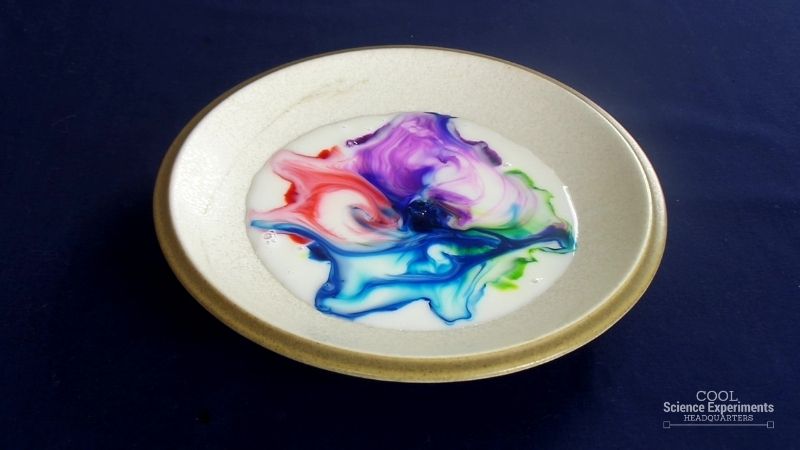
JUMP TO SECTION: Instructions | Video Tutorial | How it Works
Supplies Needed
- Milk (Must be either Whole or 2%)
- Food Coloring. The more colors the better
- Shallow Dish or Bowl
Magic Milk Science Lab Kit – Only $5

Use our easy Magic Milk Science Lab Kit to grab your students’ attention without the stress of planning!
It’s everything you need to make science easy for teachers and fun for students — using inexpensive materials you probably already have in your storage closet!
Magic Milk Experiment Instructions
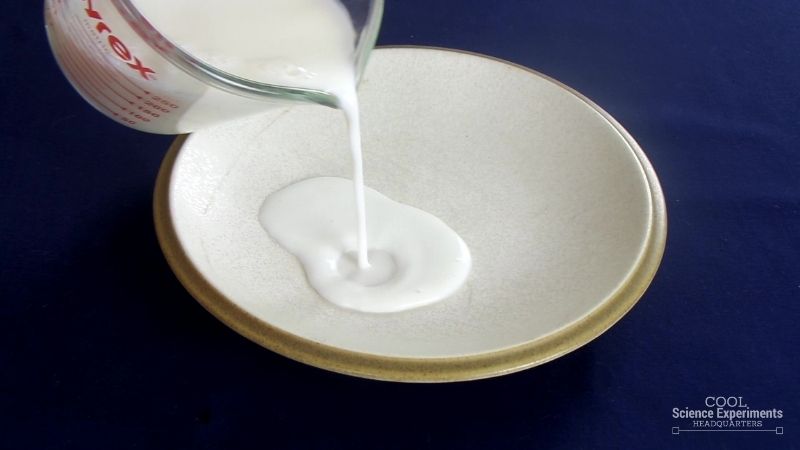
Step 1 – Pour some milk into a shallow dish or bowl until the milk covers the bottom.
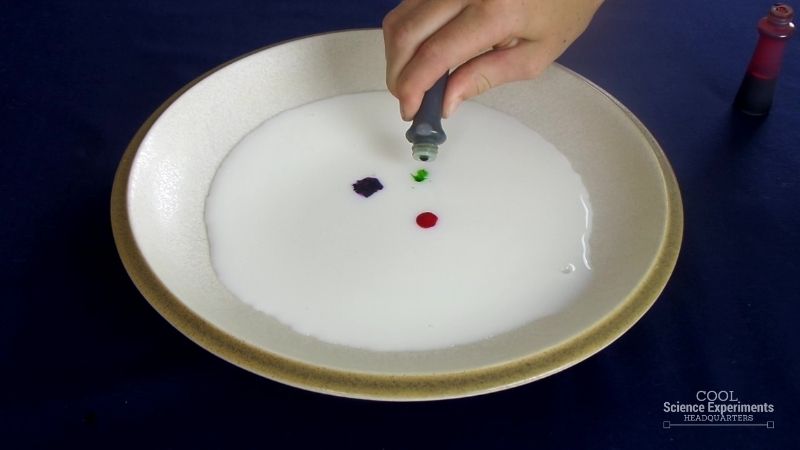
Step 2 – Add some drops of food coloring on the milk. You can use a variety of colors, just be sure to add 3-4 drops of each color.
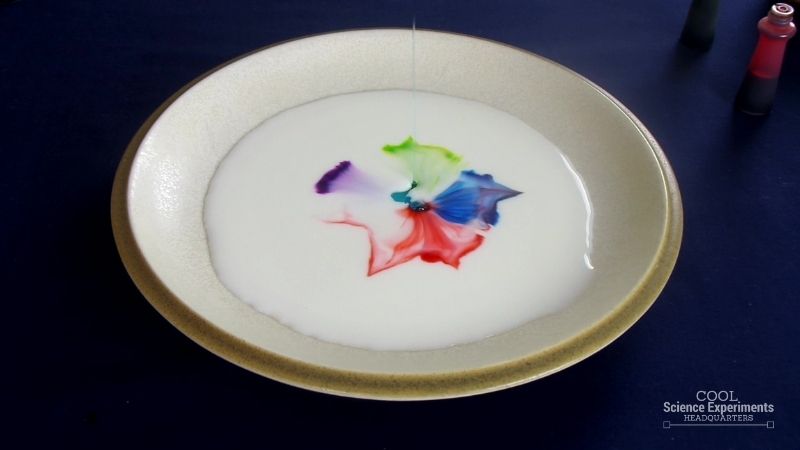
Step 3 – Add a drop of dish soap into the center of the milk.
Step 4 – Watch in amazement as the colors dances across the surface of the milk. Do you know what caused the colors to move around in the milk? Find out the answer in the how does this experiment work section below.
Video Tutorial
Detailed Magic Rainbow Milk Science Experiment Step by Step Instructions
How Does the Science Experiment Work
The key to the dancing colors in this experiment is soap! Soap molecules consist of a hydrophilic (“water-loving”) end and a hydrophobic (“water-fearing”) end. Water molecules are polar molecules that can dissolve other polar molecules. Fat (and oil) molecules are nonpolar molecules, so they cannot dissolve in water.
Milk is a mixture of water, fat, vitamins and minerals. When soap is added to the milk, it helps to separate the water and fat in the milk. When soap is mixed in with the fat and water, the hydrophobic end of the soap molecule breaks up the nonpolar fat molecules, and the hydrophilic end of the soap molecule links up with the polar water molecules. Now that the soap is connecting the fat and water, the nonpolar fat molecules can be carried by the polar water molecules.
As the soap molecules connect to the fat molecules, the molecules of the food coloring get pushed around everywhere resulting in an explosion of color! As the majority of soap molecules attach to the fat molecules and the soap spreads throughout the milk, the color explosion will slow and eventually stop. Add more soap and see if there are more fat molecules that haven’t attached to soap – if there are unattached fat molecules still, the color explosion will begin again.
This experiment works best with 2% and whole milk because they contain more fat.
Other Ideas to Try
Try this experiment again using milk with different fat percentages. Try it with skim milk, 1% milk, 2% milk, whole milk, half and half, and cream. Consider even trying evaporated milk and sweetened condensed milk. See how the amount of fat affects the explosion of color!
I hope you enjoyed the experiment as much as we did. Here are some printable instructions:

Magic Rainbow Milk Science Experiment
Instructions.
- Pour some milk into a shallow dish or bowl until the milk covers the bottom. Tip: Be sure to use either Whole or 2% Milk
- Add some drops of food coloring on the milk. You can use a variety of colors, just be sure to add 3-4 drops of each color.
- Add a drop of dish soap into the center of the milk
- Watch in amazement as the colors dances across the surface of the milk

Reader Interactions
November 11, 2019 at 6:47 pm
I did this in my science class and it worked really well! I looked at a lot of science experiments but couldn’t find one I liked and then I found this at the last minute and it was really good so thank you for sharing:)
April 12, 2023 at 9:03 pm
I agree, Emma. It has worked every time and was fun to watch! This explanation of the experiment is very informative. I have done this experiment a lot when I was younger. ☺️
August 19, 2020 at 11:48 am
It was pretty cool
October 19, 2021 at 8:33 pm
This was a really fun activity!
November 19, 2021 at 8:26 am
Because of this experiment I got to the finals of my Sci Expo
February 13, 2022 at 8:11 pm
It was actually pretty cool. I did this for my science project. Also, the colors came out really nice! i will definitely try again.
April 2, 2022 at 5:27 am
Thanks a million for these fantastic ideas and explanations!
Leave a Reply Cancel reply
Your email address will not be published. Required fields are marked *
Save my name, email, and website in this browser for the next time I comment.

- Privacy Policy
- Disclosure Policy
Copyright © 2024 · Cool Science Experiments HQ
Get Your ALL ACCESS Shop Pass here →

Magic Milk Science Experiment
How do you make magic milk or color changing rainbow milk? Let us show you how easy and fun simple science experiments can be! The chemical reaction in this magic milk experiment is fun to watch and makes for great hands-on learning. The perfect kitchen science as you already have all the items for it in your kitchen. Setting up science experiments at home is easier than you think.

WHAT IS MAGIC MILK?
We love super simple science experiments that you can pull out on a rainy afternoon (or in any weather). This magic milk experiment has to be one of our favorites and definitely for science experiments with milk!
Kids are naturally curious, and sharing fun, simple science activities at home or in the classroom is just another way to get kids to learn. We love to keep our science playful too! No two magic milk experiments will ever be the same!
Click here to get your free printable science guide!
You’ll also be sent weekly projects to your inbox! We respect your privacy. Unsubscribe at any time.
If you want to make this truly a science experiment or even a milk science fair project using the scientific method , you need to change one variable . You could repeat the experiment with different types of milk, such as skim milk, and observe the changes. Learn more about the scientific method for kids here .
- Full Fat Milk
- Liquid Food Coloring
- Dawn Dish Soap
- Cotton Swabs
NOTE: There are so many fat percentages available that the milk used is a fantastic variable to consider! Low-Fat Milk, Skim Milk, 1%, 2%, Half and Half, Cream, Heavy Whipping Cream…
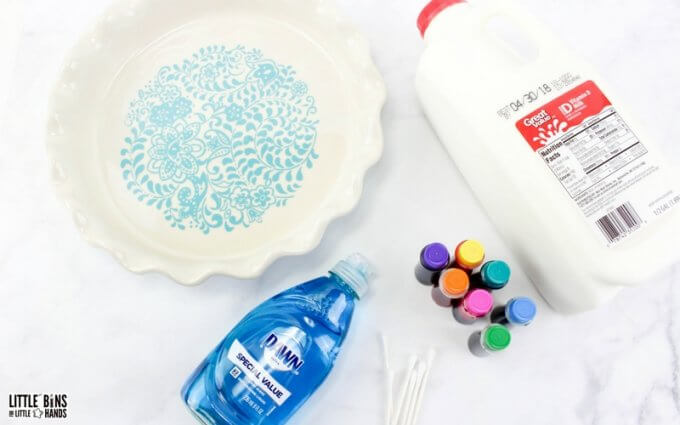
MAGIC MILK INSTRUCTIONS
STEP 1: Start pouring your whole milk into a shallow dish or flat bottom surface. You don’t need a lot of milk, just enough to cover the bottom and then some.
If you have leftover milk, try our milk and vinegar plastic experim ent !
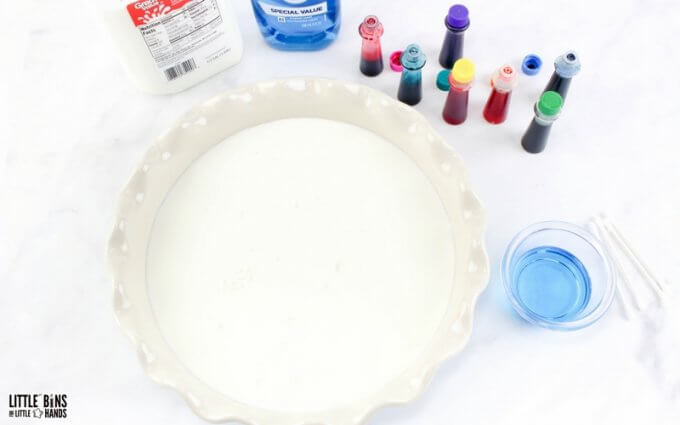
STEP 2: Next, you want to fill the top of the milk with drops of food coloring! Use as many different colors as you like.
TIP: Use a variety of colors or give your magic milk experiment a theme for the season or holiday!
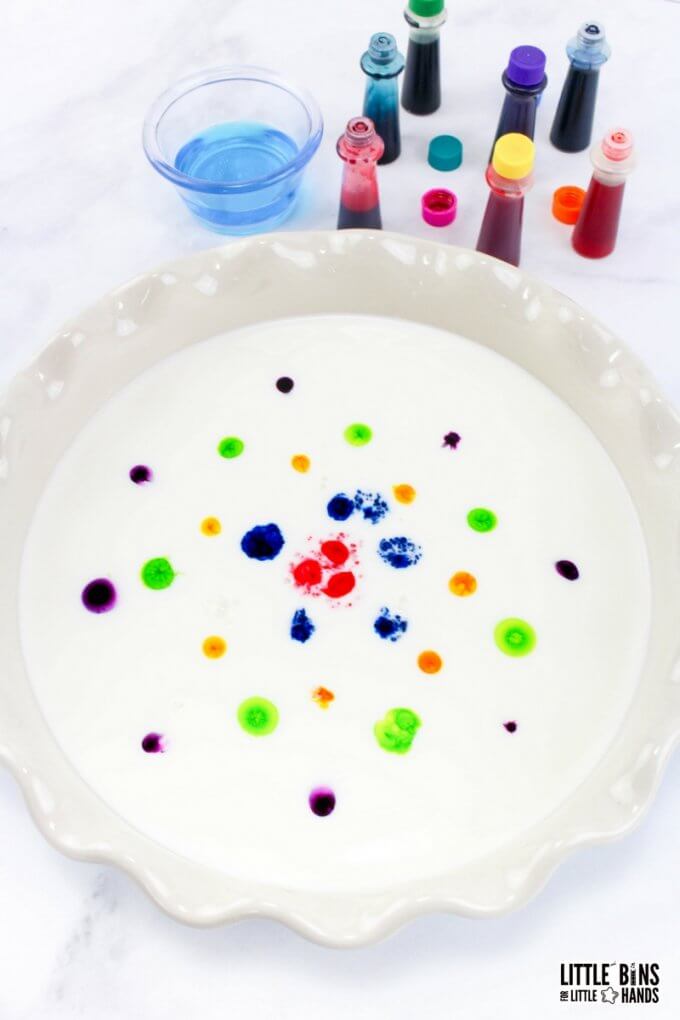
STEP 3: Pour a small amount of dish soap into a separate bowl, and touch your cotton swab tip to the dish soap to coat it. Bring it over to your milk dish and gently touch the surface of the milk with the soapy cotton swab!
TIP: Try a cotton swab without dish soap first and see what happens. Talk about what is observed, then try the dish soap-soaked cotton swab and check out the difference. This is a great way to add more scientific thinking to the activity.
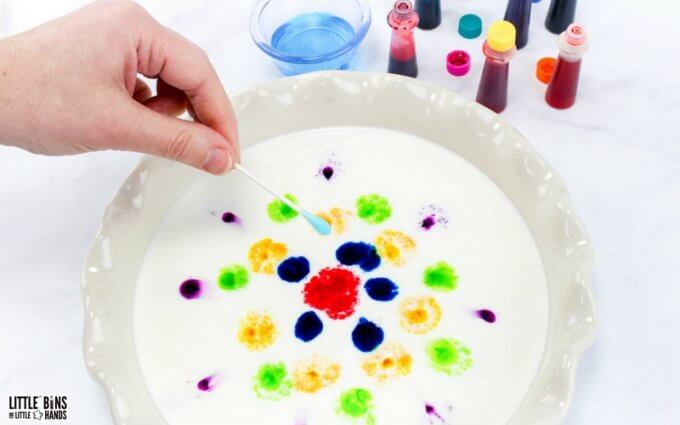
What happens? Make sure to read about how the magic milk experiment works below!
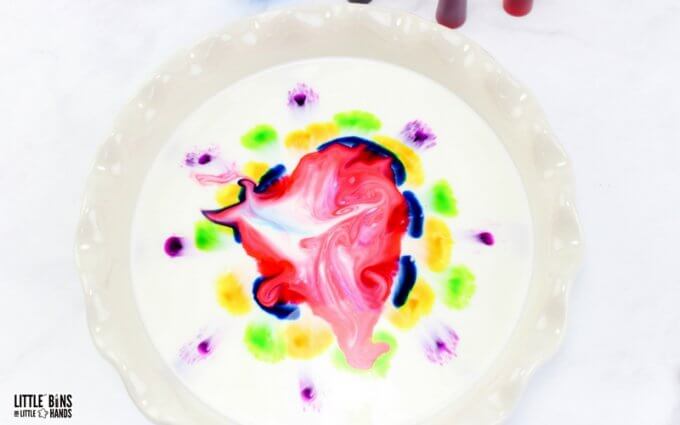
Remember, each time you try this magic milk experiment, it will look slightly different. It’s a fun fireworks science activity for the 4th of July or New Year!
Also, check out: Fireworks In A Jar Experiment
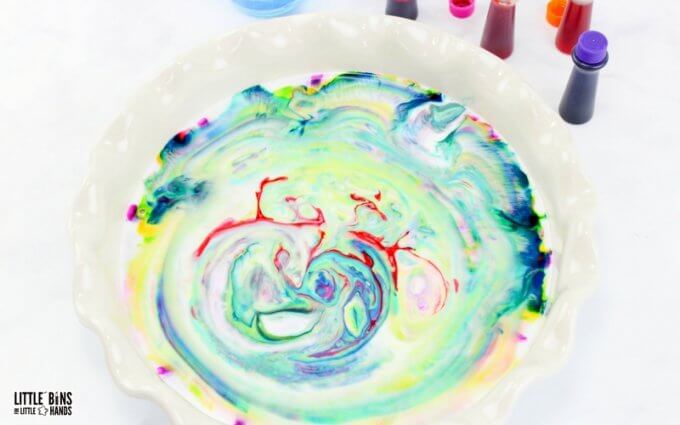
HOW DOES THE MAGIC MILK EXPERIMENT WORK?
Milk is made up of minerals, proteins, and fats. Proteins and fats are susceptible to changes. When dish soap is added to the milk, the soap molecules run around and try to attach to the fat molecules in the milk.
However, you wouldn’t see this change happen without the food coloring! The food coloring looks like fireworks because it’s getting bumped around , a color explosion.
The soap lowers the surface tension of the milk. When the soap molecules head for the fats, they form spherical micelles. This causes movement and creates cool bursts and swirls of color. After all the fat molecules have been found and equilibrium has been reached, there is no more movement. Are there any more hiding?
Try another cotton swab dipped in soap!
QUESTIONS FOR REFLECTION
- What did you notice before and after?
- What happened when you put the cotton swab in the milk?
- Why do you think that happened?
- Why do you think the colors stopped moving?
- What else did you observe?
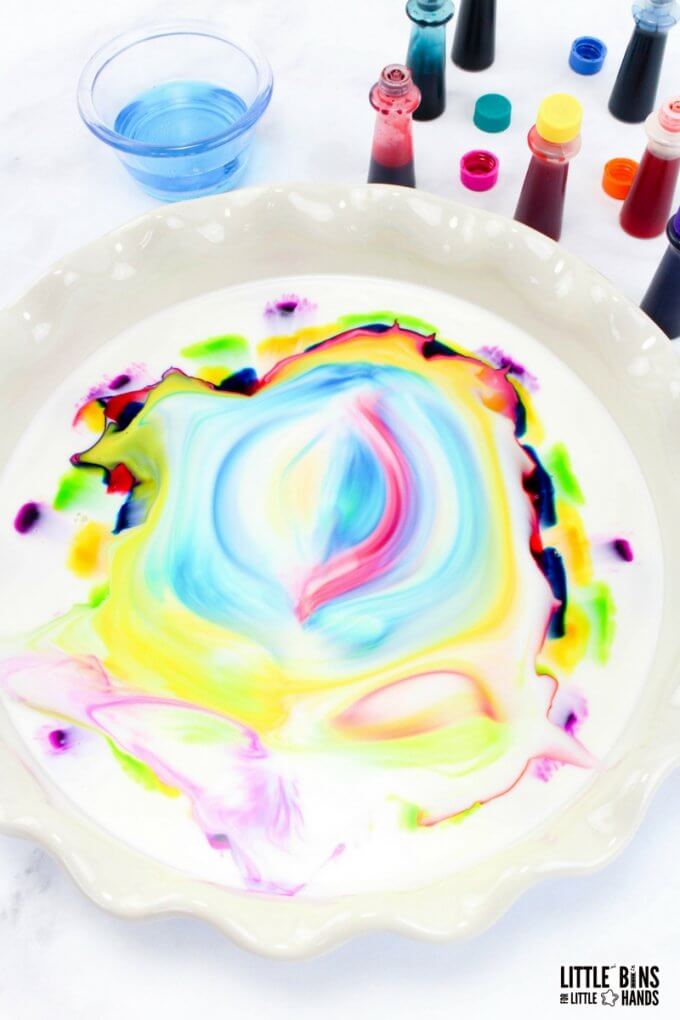
MORE FUN COLOR-CHANGING MILK EXPERIMENTS
Magic milk experiments are super easy to create themes with for different holidays! Kids love mixing in a favorite holiday with science. I know this from experience!
- Lucky Magic Milk
- Cupid’s Magic Milk
- Frosty’s Magic Milk
- Santa’s Magic Milk
MORE FUN SCIENCE EXPERIMENTS TO TRY
Love seeing chemical reactions? Check out our list of chemistry experiments for kids .
- Skittles Experiment
- Baking Soda and Vinegar Volcano
- Lava Lamp Experiment
- Growing Borax Crystals
- Diet Coke and Mentos Experiment
- Pop Rocks and Soda
- Magic Milk Experiment
- Egg In Vinegar Experiment

Printable Science Projects Pack
If you’re looking to grab all of our printable science projects in one convenient place plus exclusive worksheets and bonuses like a STEAM Project pack, our Science Project Pack is what you need! Over 300+ Pages!
- 90+ classic science activities with journal pages, supply lists, set up and process, and science information. NEW! Activity-specific observation pages!
- Best science practices posters and our original science method process folders for extra alternatives!
- Be a Collector activities pack introduces kids to the world of making collections through the eyes of a scientist. What will they collect first?
- Know the Words Science vocabulary pack includes flashcards, crosswords, and word searches that illuminate keywords in the experiments!
- My science journal writing prompts explore what it means to be a scientist!!
- Bonus STEAM Project Pack: Art meets science with doable projects!
- Bonus Quick Grab Packs for Biology, Earth Science, Chemistry, and Physics

17 Comments
This activity is a staple in my house! 🙂 I wanted to say that, even though you say it’s great for little kids, my older kids (6 and ELEVEN) still love this, too!!! I’m not kidding- my eleven year old son asked to do magic milk last month. 🙂 Great fun!
This looks like a terrific idea to do with my kindergarten class! However, is there a possible substitute I can use for the milk?
- Pingback: Erupting Lemon Volcano Chemistry for Kids Science Activities
- Pingback: 8 Homeschooling Tips for Busy Parents | The Mama Workshop
Interesting and funny experiments. I like fireworks activity. A ton of value in cheap science activities and experiments.
My son suggested swapping out the soap for sanitizer and it is awesome. The color just explodes!
- Pingback: Four July 4th Activities for Kids that Don't like Fireworks - Project Stella Resources
- Pingback: WowTurf | Milk Magic
- Pingback: 5 Toddler Friendly Science Experiments
- Pingback: Preschool Science Experiments and Science Activities
- Pingback: Valentines Day Science STEM Activities and Experiments
- Pingback: Ultimate survival guide for your child's spring break - The Novel Mama
- Pingback: Week 1 Activities – Mella Wines
- Pingback: At Home Activities for Kids – Devoted Homemaker
The experiment was fun. We read the explanation about the soap attaching to the fat molecules. We tried it with fat free milk and the same result occurred. Why?
I things with my 4 year old grandson, and this was amazing, we did over and over and when his mom came home from work, he had to show her. Thank you so much for sharing, as on a limited income your free things help me help him learn. Sincerely, it was fun looking forward to the next experiment.
Awesome! So glad to hear he loved it that much!
Comments are closed.

Subscribe to receive a free 5-Day STEM Challenge Guide
~ projects to try now ~.

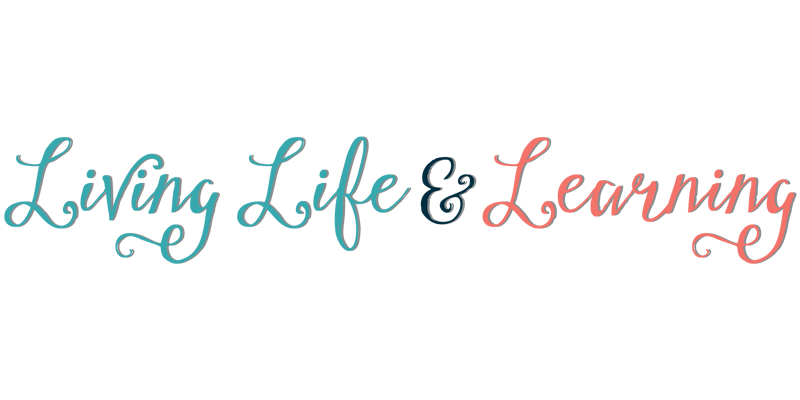
Cool Magic Milk Experiment You Have to Try
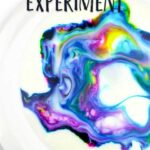
A good magic trick is fascinating. And this is one cool magic milk experiment you have to try . It’s a mind-blowing trick that will excite your kids and get them interested in learning more about magic, science and art.
If you love this, you’ll enjoy my other simple homeschool science experiments !
I used simple household products to get this stunning effect. It’s so easy but the results are amazing. And this is one that can be done relatively unsupervised if you wish, because none of the products are dangerous to kids!
Though, personally, I love to see how it works just as much as the kids do.
Plus, you have everything in your kitchen right now to get started.
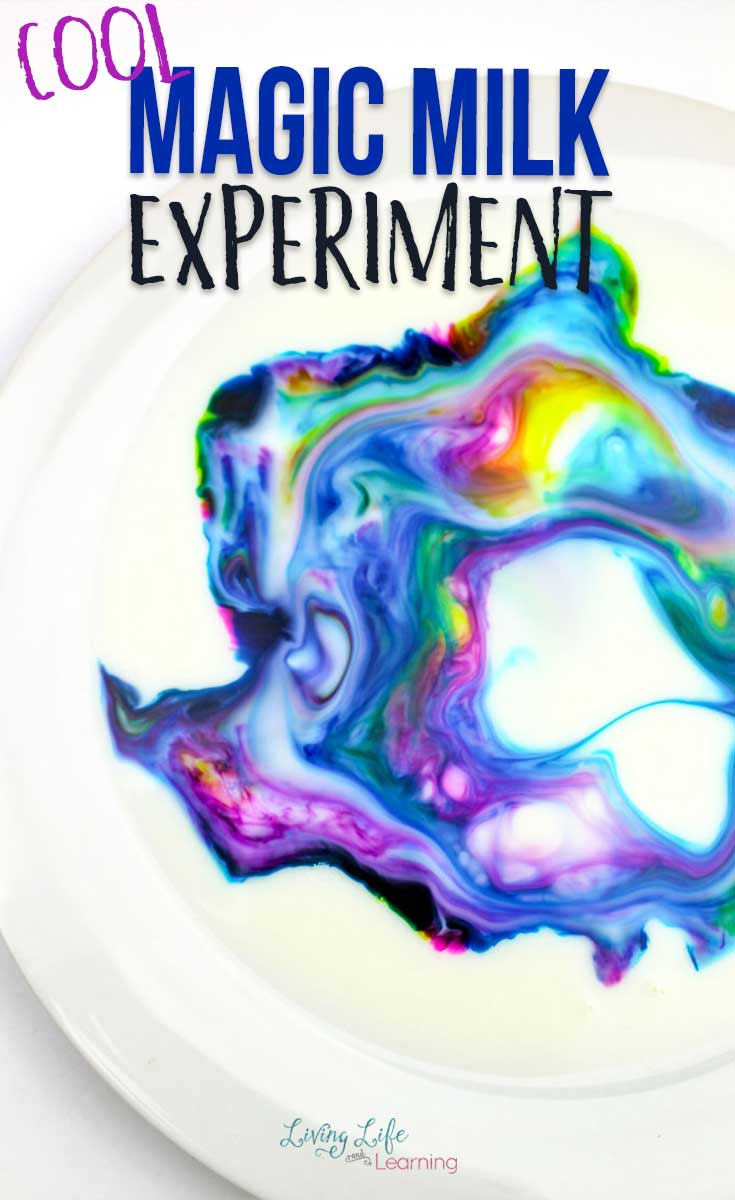
Start with some milk, preferably room temperature, some food coloring, cotton swabs, and a little dish soap. You’ll also need a shallow bowl with a lip or shallow container to hold the milk.
It doesn’t matter what colors you use, but contrasting colors will be more obvious, and coordinating colors will be more subtle. It all depends on the effect you want to see.
If you love this activity, you must try this Catapult STEM Activity with Popsicle Sticks .
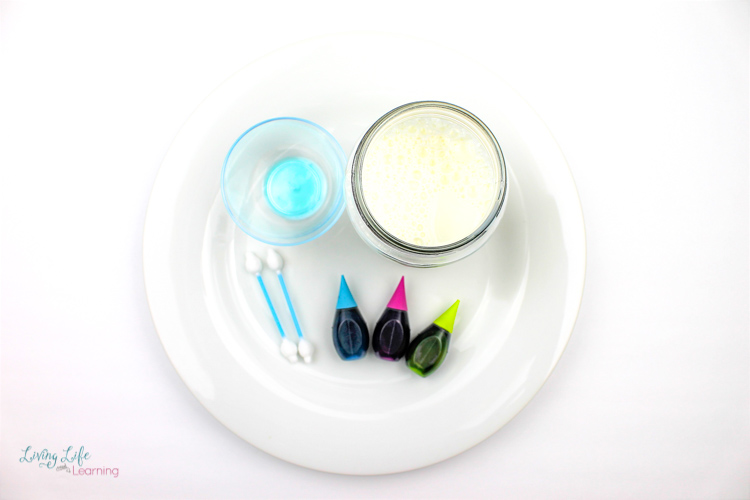
This post may contain affiliate links meaning I get commissions for purchases made through links in this post. Read my disclosure policy here.
See a list of my favorite Amazon Deals for your home and homeschool.
Why the Magic Milk Experiment Works
Contrary to what it looks like, milk isn’t just milk! It’s made up of mostly water, with a bit of fat in it, along with other nutrients — vitamins, minerals, proteins, etc.
The fat is in small droplets, held in solution in the water. That is, the fat molecules are suspended between the molecules of the water. And this fat (and the proteins) are super sensitive to changes in the milk.
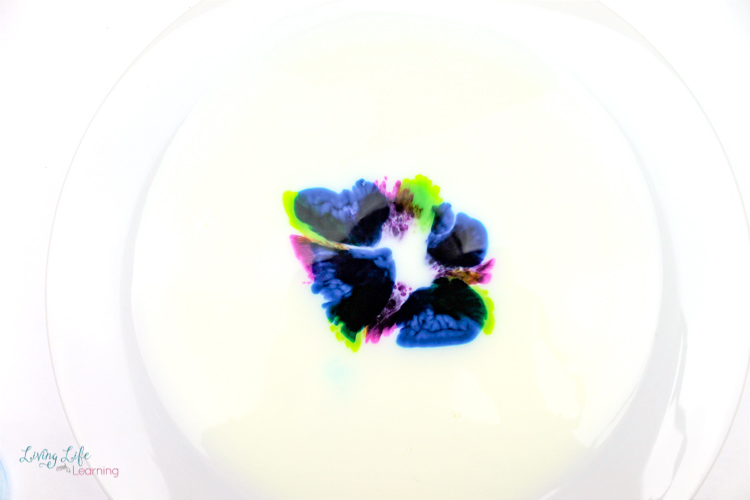
When you first add the colors to the milk, they kind of “sit” on top of the milk. They might slowly spread through it, similar to paint spreading on paper.
They are held by the water tension in the milk, on the surface. So at first, it looks like not much happens.
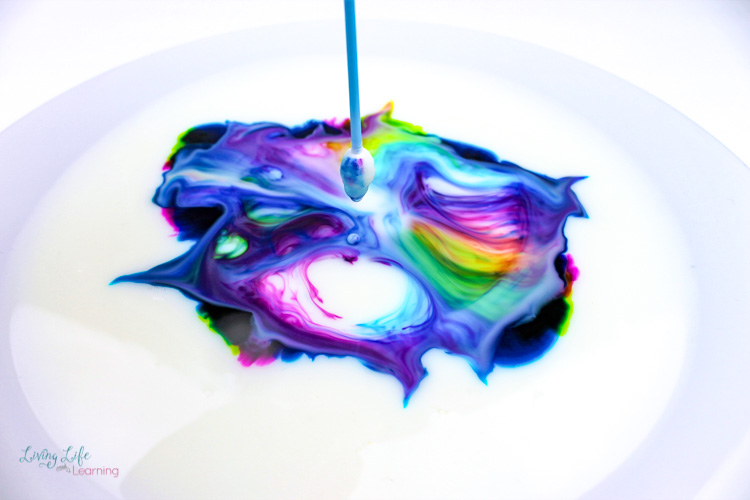
When you add the dishwashing liquid soap, that’s when things start moving — literally!
The soap molecules cause a chemical reaction that makes the colors mix together and moves around in the milk.
In fact, it’s not really the colors moving, but the food coloring that allows us to see the chemical reaction between the soap and the milk fat.
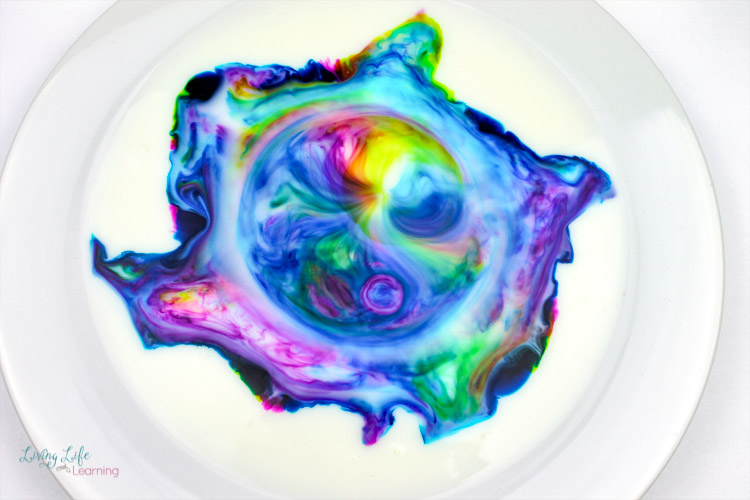
What happens in the Magic Milk Experiment
The soap also lowers the surface tension of the milk, allowing the colors to mix and move about more freely. So for a bit, you’ll see everything move around and swirl, before finally settling.
It’s a lot of fun to watch!
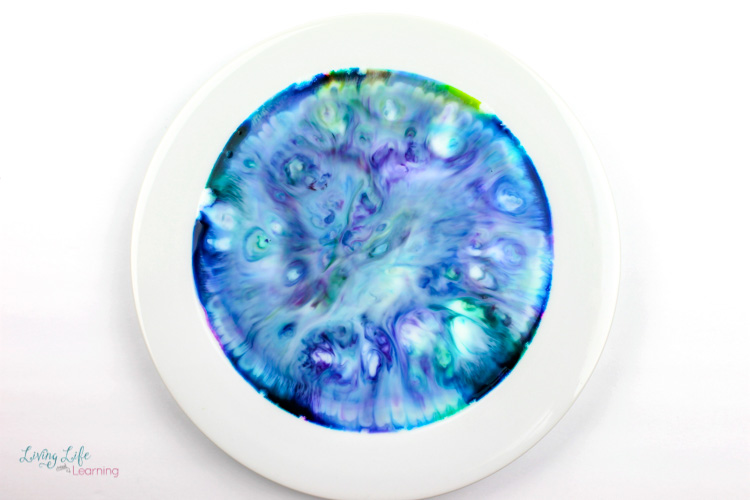
The soap reacts with both the proteins in the milk and the milk fat molecule themselves. When the soap and proteins interact, the soap makes the proteins change shape, sending them swirling, which in turn makes the colors swirl about.
And the soap and fat want to join together in pockets called “micelles” (similar to how soap lifts the grease off your dirty pans!), so that also causes movement.
Eventually, everything reaches a balance or “equilibrium”, and the reaction ends. But the milk colors will still move about for a bit as the excess energy works its way out.
Magic Milk Variations
You can change the experiment by changing up the colors and adding cookie cutters to add different themes – it’s a fun way to change things up with this classic science experiment.
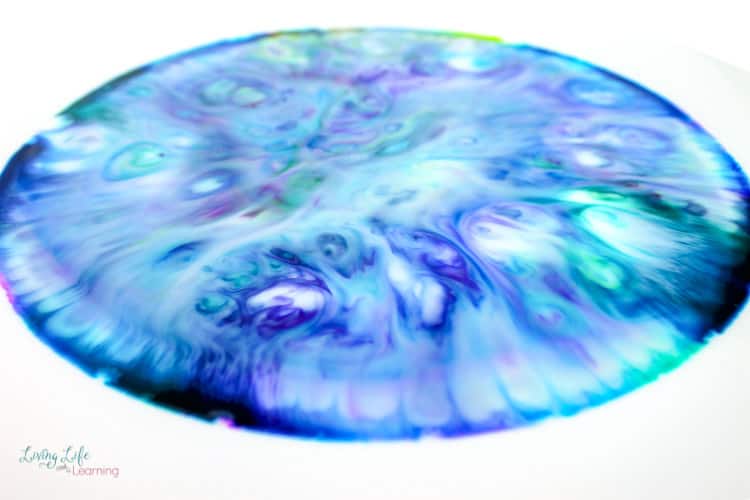
Recommended Science Experiment Books for Kids
Want more great science experiments with your kids? Check out some of our favorite science experiment books! And you can grab the instructions and materials list for this cool magic milk experiment below.
I enjoy simple science experiments that use household items that are easy to find. If you have any of these science books, you can plan ahead and gather the materials you need so you always have supplies ready to go for science.

Simple Magic Milk Science Experiment
- 1 1/2 cups of milk
- Liquid food coloring
- Cotton swabs
- Dinner plate or shallow dish
- Small container
Instructions
- Pour about one tablespoon of dish soap into a small container.
- Pour milk onto a plate. (It’s ok if you see bubbles.)
- Drip a few drops of food coloring of choice in the center of the milk. You can get creative with where you drop the drops and space them out how you wish. (Note: Food coloring may spread out slightly as pictured.)
- Dip a cotton swab into the dish soap.
- Place the cotton swab in the middle of the colors and watch what happens! You should see the colors start to spread out towards the sides of the plate and change over time. You can repeat this step a few times.
- Tip: Kids can take their cotton swab and “draw” or “swirl” in the colors. Eventually the colors will mix together until the milk becomes one color.
- If you allow the milk to sit a while before all colors are mixed completely together, you can see the milk change in neat ways as pictured here.
- Watch over time how different things look!
- When complete, dispose of milk in the sink.
Recommended Products
As an Amazon Associate and member of other affiliate programs, I earn from qualifying purchases.

Did you love this simple science experiment? Try one of these other fun science activities to add some fun science experiments to your homeschool.
More Science Experiments
Hovercraft Science Experiment
Fizzy Rainbow Science Activity
Grow a crystal rainbow
Cool Pop Rocks Experiment
Sugar Rainbow Density Tower by STEAMsational
I share educational printables and activities to help homeschoolers make learning science fun and engaging!
Leave a Reply Cancel reply
Your email address will not be published. Required fields are marked *
- Grades 6-12
- School Leaders
Get this FREE poster mailed to your school! ✨
Magic Milk Experiment: How-To Plus Free Worksheet
This classic experiment teaches kids about basic chemistry and physics.
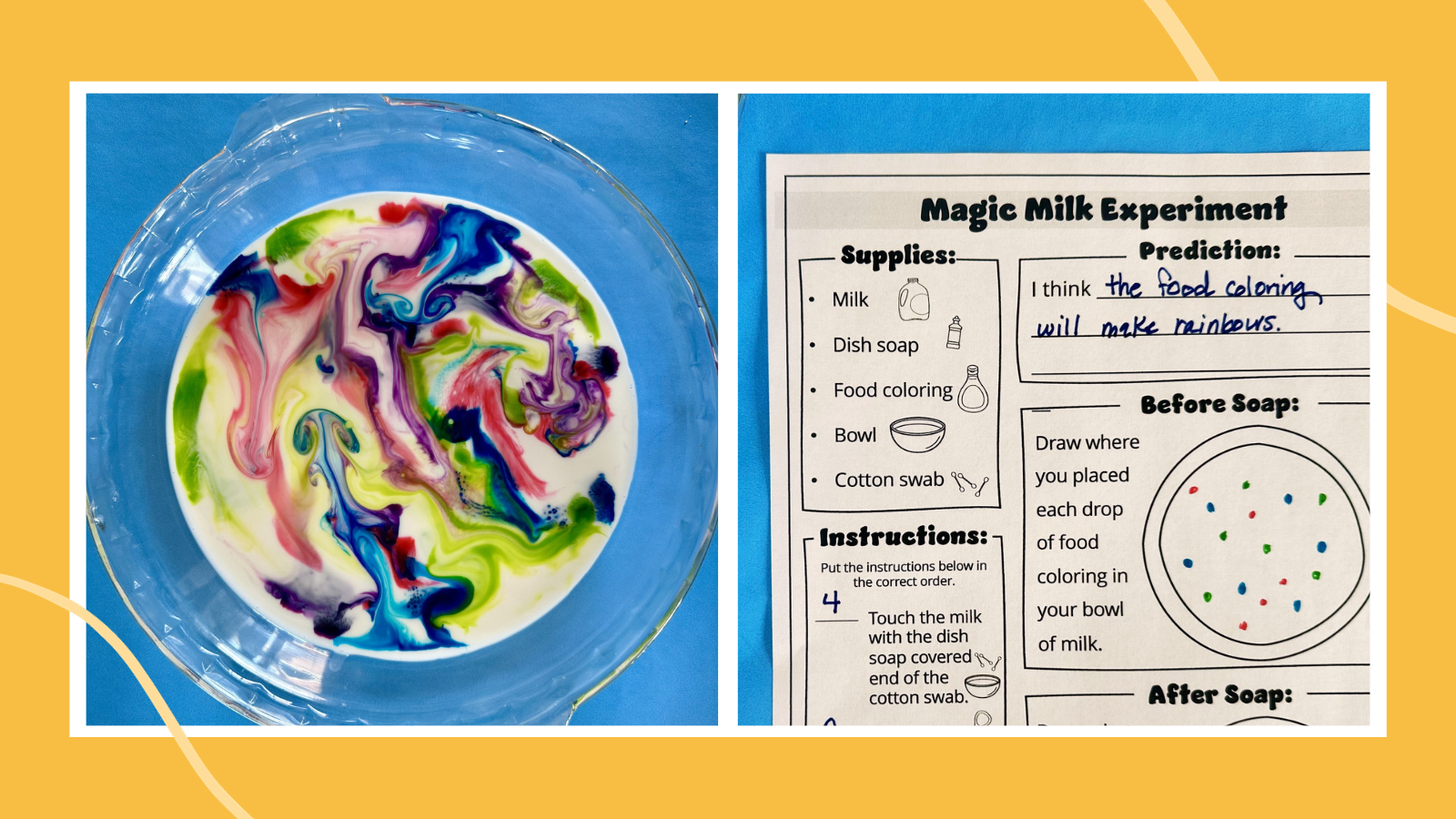
This fun experiment is a classic for a reason! In the magic milk experiment, kids learn about simple chemical reactions and physical properties using only a few ingredients. Read on to see how to do the experiment, and fill out the form on this page to grab your free recording sheet.
How does the magic milk experiment work?
In this experiment, you pour some milk into a shallow dish. You then add drops of food coloring to the surface of the milk. Using a cotton swab dipped into dish soap, you lightly brush the surface of the milk. The dish soap breaks the surface tension of the milk, and the soap molecules try to attach to the fat molecules in the milk. This causes swirls and bursts of fun rainbow colors.
What does the magic milk experiment teach?
This experiment teaches us about the science of molecules and how substances interact. The soap breaks down the fat molecules and makes them move apart, showing us a simple but fascinating example of chemistry in action!
Is there a magic milk video?
This video shows two different ways to do the magic milk science experiment, using very similar ingredients.
Materials Needed
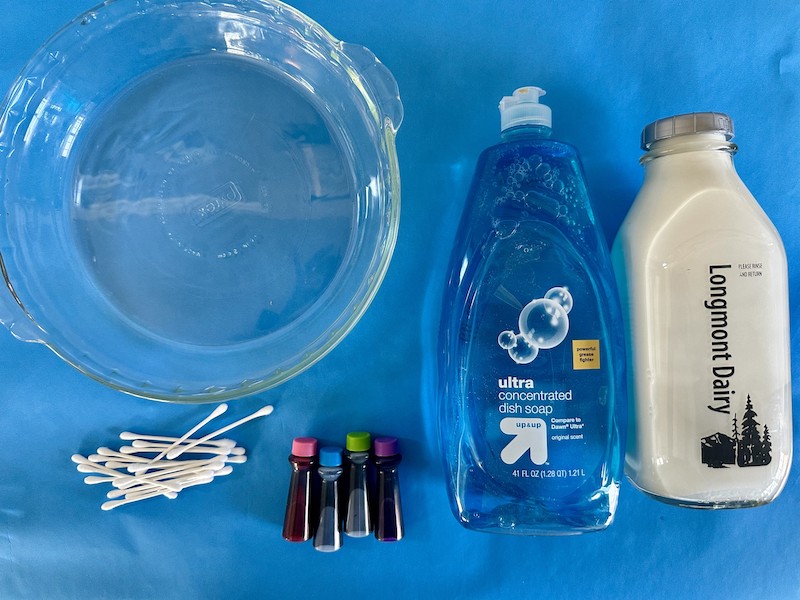
To do the magic milk experiment, you will need:
- Shallow bowl or plate
- Milk, blue dish soap
- Cotton swabs
- Food coloring (inexpensive works better than gel coloring)
Our free recording sheet is also helpful— fill out the form on this page to get it.
Magic milk experiment steps:
1. pour milk into a shallow dish or bowl, just enough to cover the bottom..
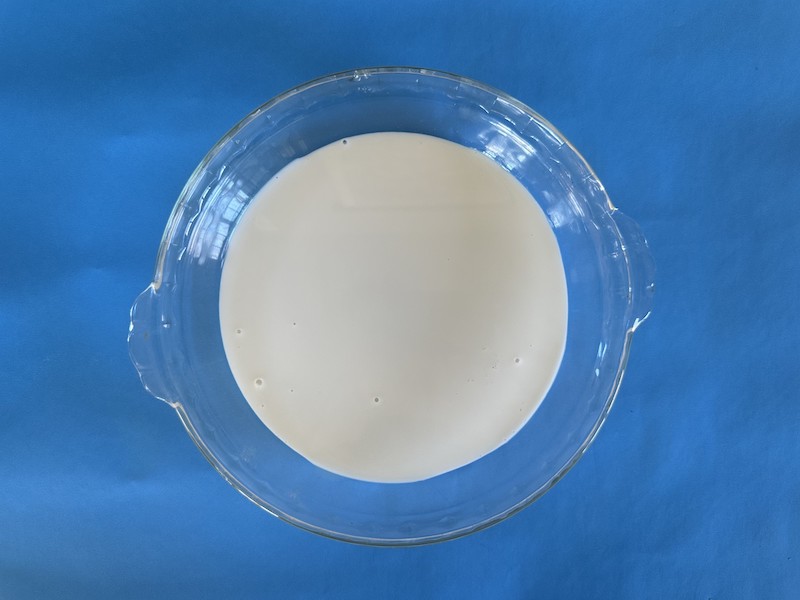
2. Add drops of food coloring all over the surface of the milk.
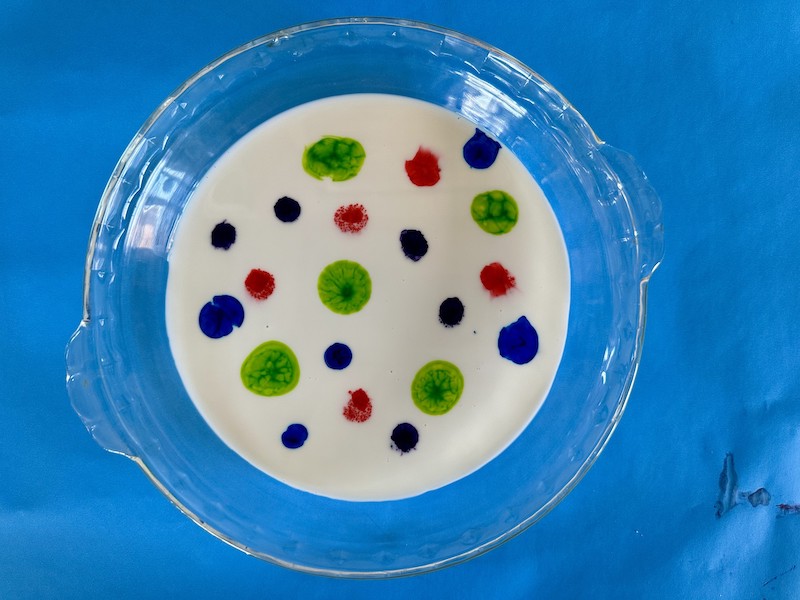
3. Dip the end of a cotton swab into a separate dish of blue soap.
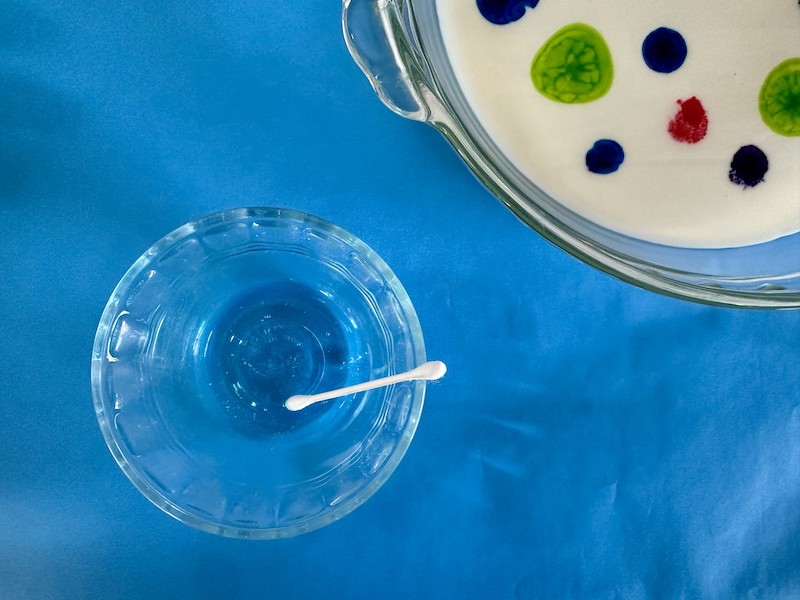
4. Lightly brush the top of the milk with the cotton swab, and watch what happens!
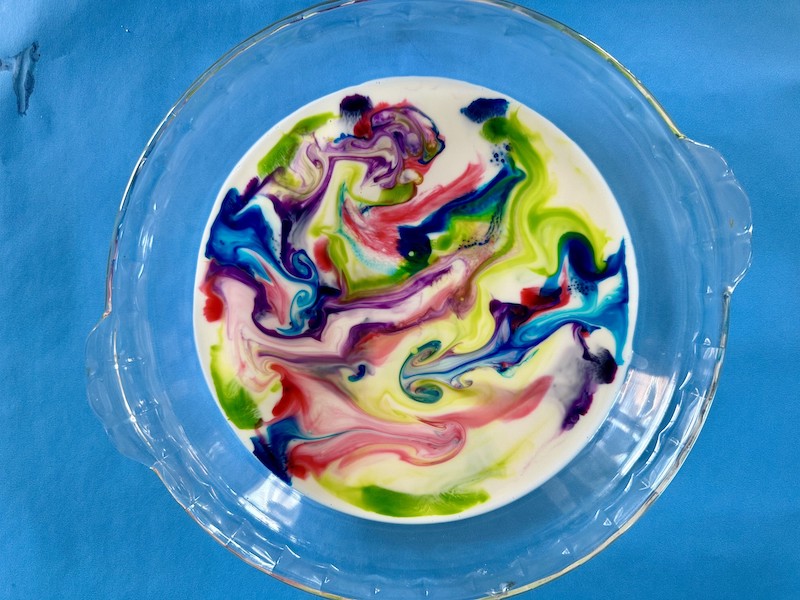
Grab our free magic milk experiment worksheet!
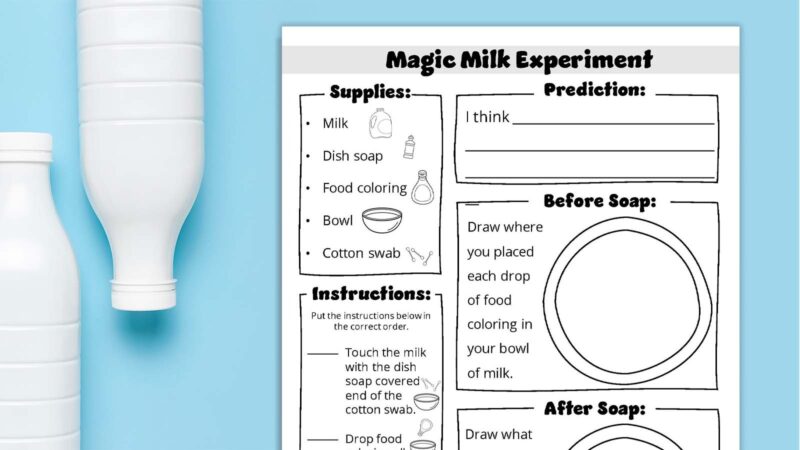
Fill out the form on this page to get your worksheet. The worksheet asks kids to guess the correct order of the steps in the experiment. Next, kids must make a prediction about what they think will happen. They can use the provided spaces to draw what happens before and after they add the dish soap. Did their predictions come true?
Additional Reflection Questions
- What happened when we added the soap to the milk?
- Why do you think the colors appeared on the milk’s surface?
- What do you think would happen if we added more soap to the milk?
- What do you think would happen if we used a different liquid instead of milk?
Can the magic milk experiment be done for a science fair?
Yes! If you want to do the magic milk experiment for a science fair, we recommend switching up some of the variables. For example: Does the fat content of the milk matter? Does the type of dish soap matter? Form a hypothesis about how changing the variables will impact the experiment. Good luck!
Looking for more experiment ideas? Check out our big list of experiment ideas here.
Plus, be sure to subscribe to our newsletters for more articles like this., you might also like.
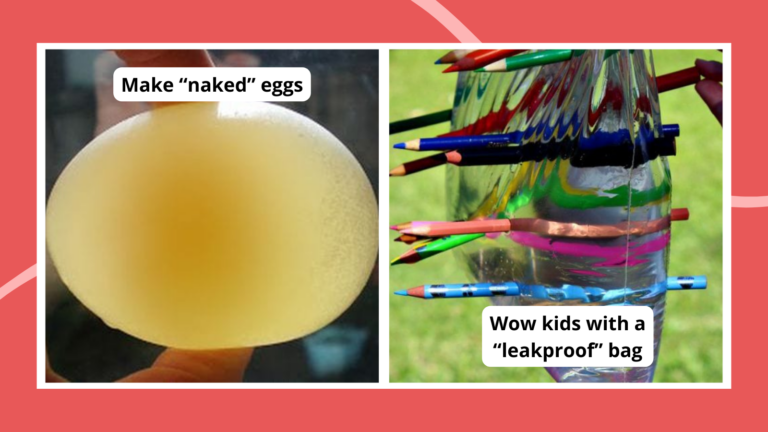
72 Easy Science Experiments Using Materials You Already Have On Hand
Because science doesn't have to be complicated. Continue Reading
Copyright © 2024. All rights reserved. 5335 Gate Parkway, Jacksonville, FL 32256
Download Now : Our FREE 30 Minute Weeknight Dinner

Magic Milk STEM Experiment: Colorful Science for Kids
Are you ready to have some STEM fun with your kiddos? There’s more to this Magic Milk experiment than meets the eye. Learn all about color mixing, chemical reactions, surface tension, and more!

STEM activities provide a fantastic opportunity for kids to explore the world around them and develop a love for science. The “Magic Milk” experiment combines the principles of chemistry and color theory to create a visually appealing and fun learning experience.
Magic Milk is a simple, inexpensive, and safe STEM activity that kids of all ages can enjoy!
Whole milk, food coloring, and a bit of dish soap come together to show children a magical explosion of colors.
This activity not only piques their curiosity but also serves as an excellent teaching moment to delve into the science behind the colorful phenomena. Learning the concepts of surface tension, chemical reactions, and color mixing can begin to cultivate a lifelong love for STEM subjects.
This is one of those simple science experiments that can teach kids things they never thought of before! I first learned about this food coloring experiment (and many other simple experiments) from the Steve Spangler Science website .
If you love doing STEM activities with your kids, make sure you check out my Earth Day Science Experiment and Snow Volcano Experiment activities too!
Let’s dive in and have some science fun!

The Science Behind Magic Milk
You might be wondering what causes the amazing color explosion in the magic milk STEM activity. There are several factors to consider in this fun science experiment:
To understand what’s happening in the Magic Milk STEM activity, it’s important to know that milk is made up of water, vitamins, minerals, fats, and protein molecules. In this experiment, you observe the interaction between fat (in the milk) and soap.
The type of milk you use for this activity matters . Whole milk has a higher fat content (roughly 3.25%) than reduced-fat varieties (like 2% or 1%).
The fat content of the milk is important for the chemical reaction involved in the activity.
Love crafts and easy DIY projects? Grab this mini activity book for more by clicking the image below – free! 👇


Food Coloring
Now, let’s move on to the color explosion. The magic milk experiment relies on the interaction between milk’s fat molecules and dish soap.
When you add dish soap to the plate of milk, its molecules mingle with the fat molecules, causing swirling patterns of color. This is because dish soap molecules have a dual personality, with a water-loving head (hydrophilic end) and a water-fearing (hydrophobic) head or end.
As the soap molecules find their way into the milk, the hydrophobic end of a soap molecule grabs fat molecules. This forms little clusters called micelles, where the soap molecules surround and isolate the fat molecules.
The colorful twist comes from the food coloring you’ve added to the milk. As the micelles move around, they push the food coloring molecules into different paths, leading to a rainbow of colors and mesmerizing patterns.
Surface Tension
The surface tension of the milk also plays a role in this activity. Surface tension is a property of liquids where molecules at the surface form a sort of dome due to their molecular bonds.
The dish soap disrupts the equilibrium of the milk’s surface tension, allowing the micelles to move freely and create those beautiful swirling patterns.
Magic milk is a great visual representation of scientific concepts, making it an excellent choice for a milk science fair project. Have fun experimenting with different types of milk to see how the fat content affects the results, and enjoy the dazzling display of colors!

Magic Milk Science Experiment Materials Needed
All you need to do this are a few common everyday ingredients you likely already have in your kitchen!
Let’s make sure you have everything ready to dive into some colorful, milky science by gathering up these supplies:
- Whole milk – other percentages can be used as a variable
- Liquid food coloring – in a variety of colors like primary colors or pastel colors (I used orange, green, yellow, red)
- Dish soap (e.g., Dawn dish soap)
- Q-tips – cotton swab or cotton ball

Magic Milk Step-by-Step Directions
Introducing the Magic Milk STEM activity, an engaging and fun experiment for kids and preschoolers. This eye-catching activity provides a great opportunity for little scientists to observe fascinating color changes and reactions. Follow this friendly, step-by-step procedure to create some science fun at home.
Pour milk onto the large, shallow glass plate. Pour just a thin layer of milk to cover the bottom of the plate.

Drop 4-5 drops of food coloring (in the colors of your choice) around the plate. Leave a little space between each drop.
Pro Tip: You can use as many colors as you like, and placing them near each other will create more exciting visual effects.

Each time you use a color, add a drop of dish soap to your cotton swab.

Place the Q-tip in the middle of the food coloring in the milk.
Watch what happens to the food coloring!
Swirl the Q-tip around and ‘paint’ the milk. Watch the cool patterns in the milk as you do this.

Observe The Magic Milk In Action
Touch the dishwashing liquid-covered Q-tip gently to the milk’s surface, preferably near the food coloring drops.
You’ll quickly notice the food coloring appears to burst and dance across the surface of the milk. This happens because the dish soap breaks down the fat molecules in the milk, causing the molecules to move quickly and spread out the food coloring within the milk.
The result is a mesmerizing display of swirling colors that is sure to inspire young minds!
Magic Milk Experiment Variations and Extensions
This experiment is easy and uses inexpensive materials. More importantly, it’s fun for kids!
If you’re looking to expand on the magic milk STEM activity, here are a few options to consider:
- Experiment with different types of milk: Try using different types of milk, like skim milk, 1%, 2%, and whole milk to observe how the variations impact the experiment. Compare the results and see if your child can determine if the fat content in the milk has an effect on how the colors move. You can also try using different kinds of milk , such as almond, soy, or oat milk, to see how that variable impacts your results.
- Play with the colors: Encourage your child to mix different food colors and see what new colors they can create in their rainbow milk experiment. This will give the experiment a creative touch and help your child learn color combinations when mixing different colors.
- Gel food coloring: To take the experiment to another level, try using gel food coloring instead of liquid. Gel food coloring is more concentrated, so it might produce different results. This variation can help your child learn about the different forms and properties of colorants.
- Create patterns: Teach your child to create various patterns (such as concentric circles), different shapes, a color grid, or even draw a simple picture using the food coloring drops. This offers to make an art project out of the science experiment.
- Play with the thickness of the milk: Instead of a thin layer of milk on a dish, what happens if you use a glass of milk?
Here are some additional ideas for color-changing milk experiment variations and extensions that can be tried at home:
- Use a dropper to add the dish soap, and try placing it at different spots on the milk to see how the colors react.
- Experiment with different dish soap brands or even liquid hand soap, comparing how they affect the color explosion in the milk.
- Place a piece of paper on top of the milk after the colors have exploded and gently press on it. Carefully lift the paper and let it dry, creating a beautiful, one-of-a-kind piece of art!
Enjoy exploring these easy science experiment variations with your child, allowing them to develop their creativity while learning about the properties of liquids and colors.

Important Magic Milk Safety Notes
First and foremost, always have adult supervision when conducting this experiment with young children. While the materials involved are generally safe, adult guidance will help avoid any mishaps and ensure proper handling of the supplies.
Keep the food coloring and dish soap out of reach of children.
Here are some essential safety tips to remember while performing the magic milk activity:
- Use only non-toxic food coloring and dish soap that are safe for children.
- Be mindful of possible allergies to milk or any other ingredients used in the activity. If a child has a milk allergy, consider using a non-dairy alternative.
- Gently pour the milk into the shallow dish to prevent any spills, and securely close the food coloring and dish soap containers when not in use.
I HIGHLY recommend having paper towels or cleaning cloths handy to clean up any spills immediately to avoid stains.
Magic Milk Questions to Consider
As you conduct the magic milk STEM activity and take note of your magic milk experiment results, it’s helpful to keep a few questions in mind to promote critical thinking, observation, and understanding of the underlying concepts.
What did you notice before and after?
Did you notice a plain layer of milk and food coloring drops sitting on top before you started the experiment? After adding the dish soap and witnessing the reaction, focus on the patterns and changes in the colors.
Comparing these observations before and after will help you understand how the dish soap interacts with the milk.
What happened when you put the Q-tip in the milk?
When you dipped the Q-tip in dish soap and touched it to the milk surface, the colors likely moved rapidly and created an explosion of vibrant patterns.
Take note of how the colors interacted with each other, and how the movement changed over time.
Why do you think that happened?
This reaction occurs because the dish soap disrupts the bonds between fats and water molecules in the milk, causing the food coloring to move along with the separation.
Consider how the chemicals in the dish soap and the properties of the milk contributed to this effect.
Why do you think the colors stopped moving?
Eventually, the colors will slow down and stop moving. This is because the dish soap has reached a saturation point, where it cannot disrupt any more molecules in the milk.
It’s interesting to explore how saturation affects the reaction and its limits.
What else did you observe?
Apart from the main reaction, there may have been other subtle details to observe. For example, maybe you noticed that different food coloring colors spread at different rates or created distinct patterns. Reflecting on your overall observations can lead to deeper comprehension and appreciation for the magic milk experiment.

Frequently Asked Questions
Whole milk is the preferred choice for the magic milk experiment due to its higher fat content. The fat in the milk interacts with the dish soap, allowing the food coloring to spread and create the “magic” effect. You could also use 2% milk, but the results might not be as vibrant.
The magic milk experiment is a short-lived activity. Once you’ve mixed in the dish soap, the reaction occurs for a few minutes before the food coloring settles and the milk returns to its original state. It’s best to enjoy the experiment while it’s happening and not try to preserve or store the outcome.
If you’re having trouble with your magic milk experiment, there could be a few reasons. First, make sure you’re using whole milk, as the high fat content is essential for the best results. Second, ensure you’re using liquid food coloring, as gel or powdered forms may not produce the desired effect. Finally, check that you’re adding the dish soap correctly: add just a drop of soap in the center of the milk and the food coloring to see the reaction take place.
The magic milk experiment relies on the fat content in dairy milk for the reaction to occur. Almond milk, being a non-dairy milk substitute, generally has a lower fat content than whole milk. Although you can still try the experiment with almond milk, the results may vary and might not be as vibrant or impressive.
More Hands-On Fun
Isn’t this science activity lots of fun?! If you want even more great ideas and inspiration, check out these posts:
- Dancing Raisins Experiment
- Fireworks In A Jar Science Experiment
- Easy Rainbow Walking Water Experiment
- DIY Rainbow Spaghetti For Sensory Fun
- How To Melt Crayons Into New Shapes

Magic Milk STEM Experiment
Ingredients.
- Large dinner plate
- 1-2 cups of whole milk
- Food coloring (orange, green, yellow, red)
- Small container dish soap
Instructions
Pour milk onto the large glass plate. Pour enough milk to cover the bottom of the plate.
Drop 4-5 drops of each color of food coloring around the plate. Leave a little space between each drop. Dip a Q-tip into the dish soap each time you use a color.
Place the Q-tip in the middle of the food coloring in the milk. Watch what happens to the food coloring!
Swirl the Q-tip around and ‘paint’ the milk. Watch the cool patterns in the milk as you do this.
Similar Posts

The Best Free Back-To-School “All About Me” Printable

144 Fun Things To Do During Summer Vacation For Kids

Best Free Thanksgiving Coloring Pages For Kids

Banish first day jitters with these 6 tips!

Free Alphabet Playdough Mats Printable For Kids

Dancing Raisins Experiment: Fun Science in Action!
Leave a reply cancel reply.
Your email address will not be published. Required fields are marked *
This site uses Akismet to reduce spam. Learn how your comment data is processed .

Rainbow Magic Milk Science Experiment
Science or magic? This rainbow dancing Magic Milk Science Experiment is a fun way to explore the chemistry of surface tension.
This is one very cool experiment. To kids, it can appear more than a little magical but the effect is all science – no magic here. It’s a chemical reaction with surface tension in action! Check the explanation below the experiment procedure for more information about how and why the magic milk experiment works.

You will need:
- 1 Tablespoon dish soap/dishwashing liquid in a small container
- 1 1/2 cups of whole/full fat milk
- 10 drops of each of your chosen colours of liquid food colouring
- Dinner plate
- Cotton swab
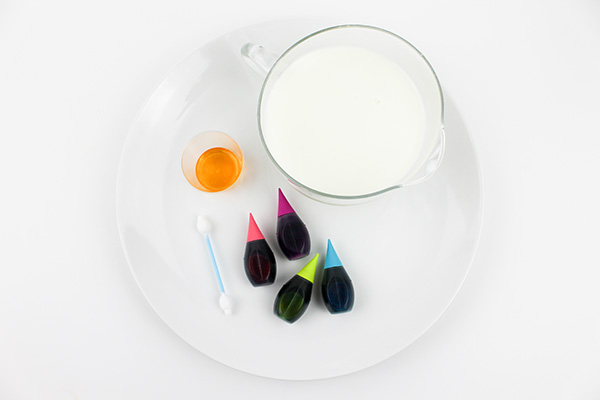
1. Pour about one tablespoon of dish soap into a small container. Set aside.
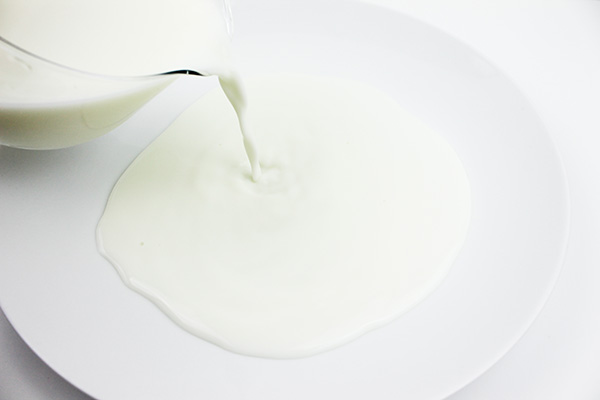
2. Carefully pour milk onto a dinner plate. It’s okay if you see bubbles in the milk. Let the milk sit for a minute so that it stops moving in the dish, becoming completely still.

3. Drop food colouring into the milk in the middle of the dish. Keep the colours separate. The food colouring may spread out slightly as you can see pictured in our photos. You can get creative with where you place the drops and space them out how you wish.
We used neon food colouring for this activity, which looks really cool but you can stick with a classic colour palette or experiment with using just warm colours or cool colours.

4. Dip a cotton swab into the dish soap.

5. Place the dipped cotton swab in the middle of a colour and observe the magical reaction! You should see the colours start to spread out towards the sides of the plate. They will continue to move and change over time.

You can repeat this step a few times, placing the cotton swab in different areas of the milk/colouring mix.
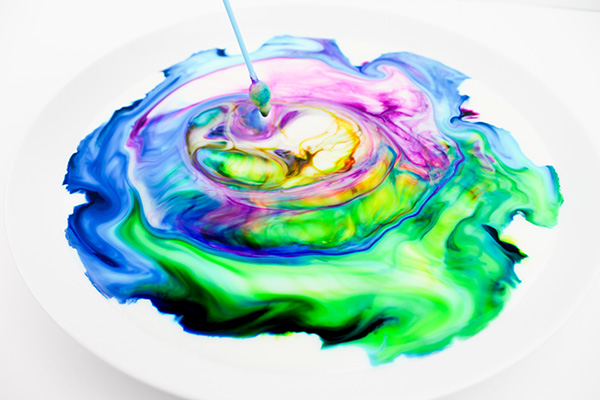
Tip: Kids can also take their dipped cotton swab and “draw” or “swirl” in the food colouring. Eventually the colours will mix together until the milk becomes one color.
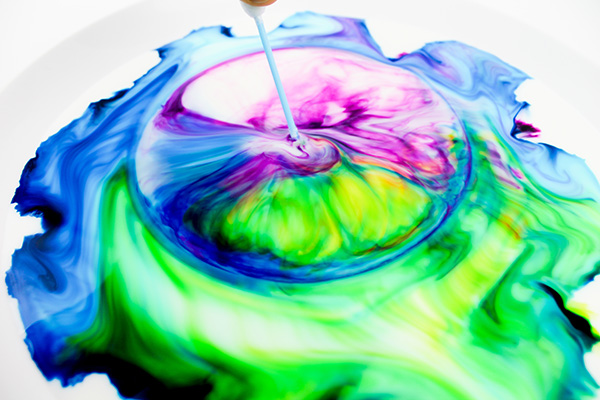
If you allow the milk to sit a while before all colours are mixed completely together, you will see the milk continue to move and change in really neat ways, as you can see in the photos.
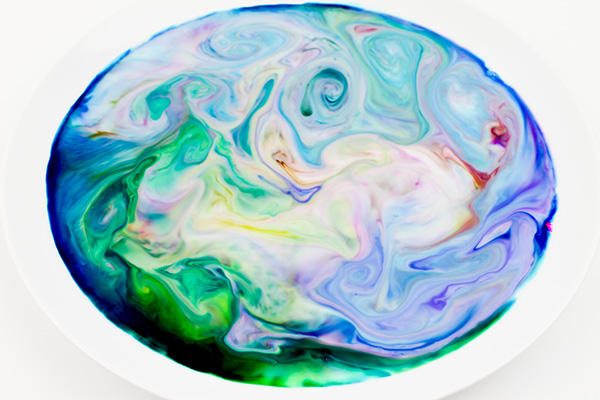
Watch over time how different things look!
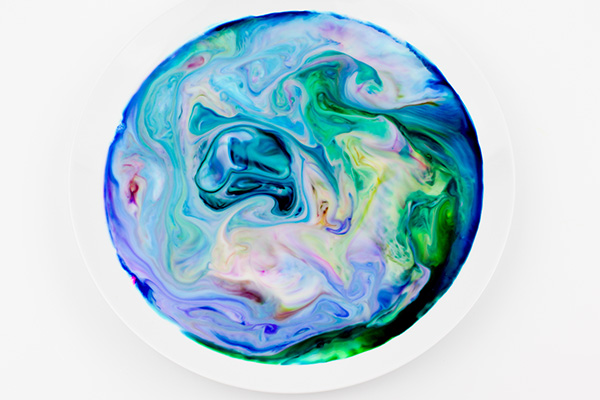
6. When complete, dispose of milk in the sink.
The Science Behind the Magic Milk Experiment:
Milk as a liquid is composed primarily of water, with much smaller percentages of carbohydrate, fat, protein and vitamins/minerals. Milk composition does vary according to the species and breed of animal, the animal’s feed and the stage of lactation of the cow.
Because of its web of hydrogen bonds, water molecules are highly attracted to each other, resulting in a high surface tension.
When the dish soap is added to the milk the soap acts as a surfactant , reducing the surface tension of the milk so that the food colouring can spread out.
Surfactant (definition): substance such as a detergent that, when added to a liquid, reduces its surface tension, thereby increasing its spreading and wetting properties. (source: britannica.com)
At the same time, the phosphates in the dish soap are reacting with the fat and protein content of the milk – the soap is trying to grab the globules of fat out of the milk to break them down, just like dish soap breaks down the grease when washing up. This interaction causes the fat particles to move around, creating the resulting swirls of moving colour.
For more STEM fun involving magic and colour, be sure to check out our cool eResource – Rainbows & Kaleidoscopes: 25 STEAM Activities Exploring Colour (and Color!) .
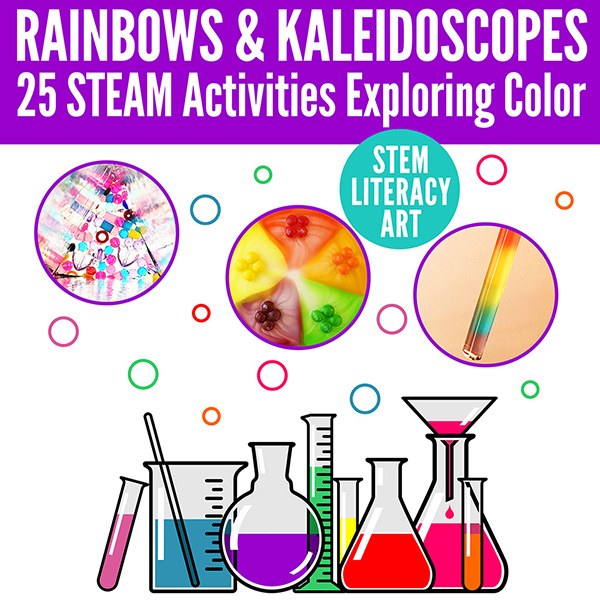
For fun, watch the magic milk experiment in action on a HUGE scale;

Christie Burnett is a teacher, author and mother of two. She created Childhood 101 as a place for teachers and parents to find engaging, high quality learning ideas.
See our latest activities and ideas first!

Magic Milk Science Experiment for Kids with Video

The Magic Milk Science Experiment is a fun and simple experiment for children of all ages. It’s an excellent Science idea for preschoolers and Kindergarten as an introduction to learning about chemical reactions and colors. This color-changing milk experiment is guaranteed to become one of your favorite kitchen chemistry experiments, and you can change up the colors for seasons and holidays.
Milk Science Experiment
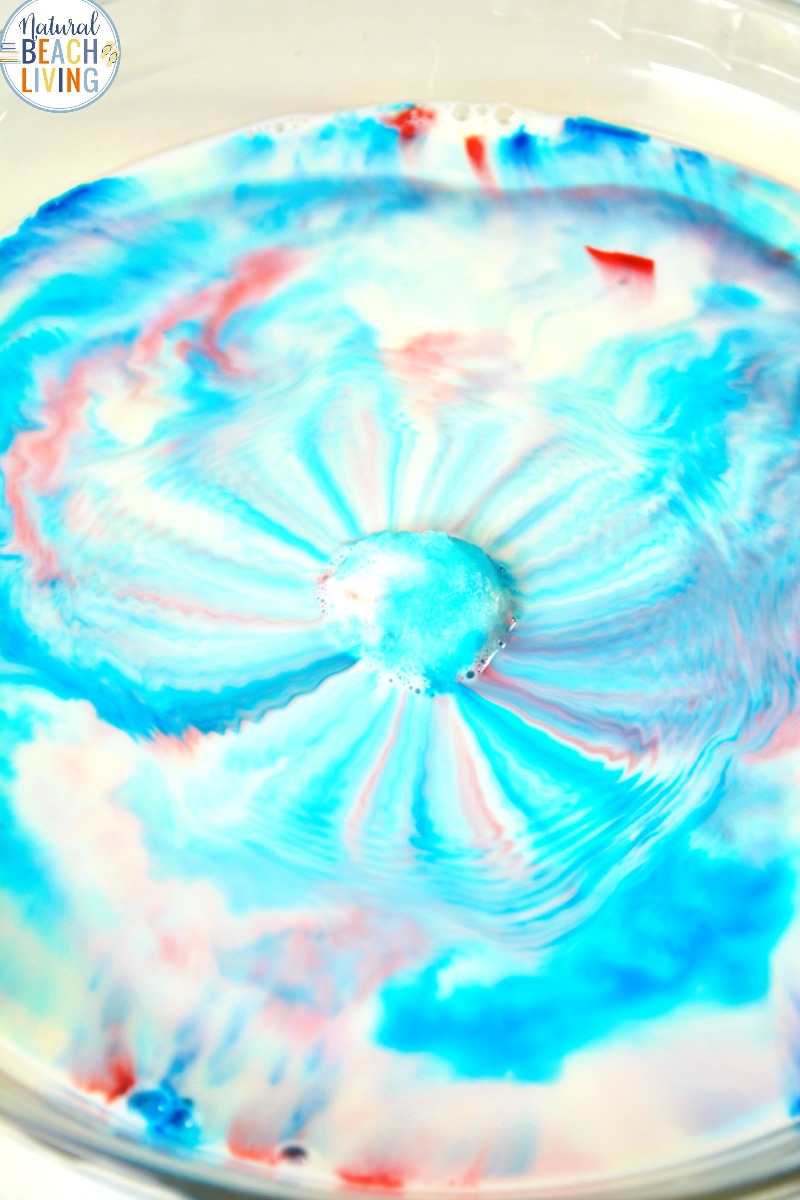
Magic Milk Science Experiment for Kids
Not only is this Magic Milk Experiment easy and fun for kids, but it’s also a great way to teach them about the science of milk! All you need is some milk, food coloring, and dish soap – and you’re ready to amaze your little ones with this cool chemistry trick.
Magic Milk Experiment Explained
Magic milk is a popular science experiment that involves using everyday ingredients to create a dramatic color-changing reaction when food coloring is added. By adding whole milk and dish soap to a shallow bowl and then carefully dripping in drops of lemon juice, vinegar, or diluted baking soda, fascinating reactions occur as the magic milk starts to move and change colors.
This experiment allows kids to explore everyday substances found around the house – grocery store lemon juice, dish soap, and milk! – while learning about the science behind chemistry, surface tension, and chemical reactions.
Science Activities for Kids
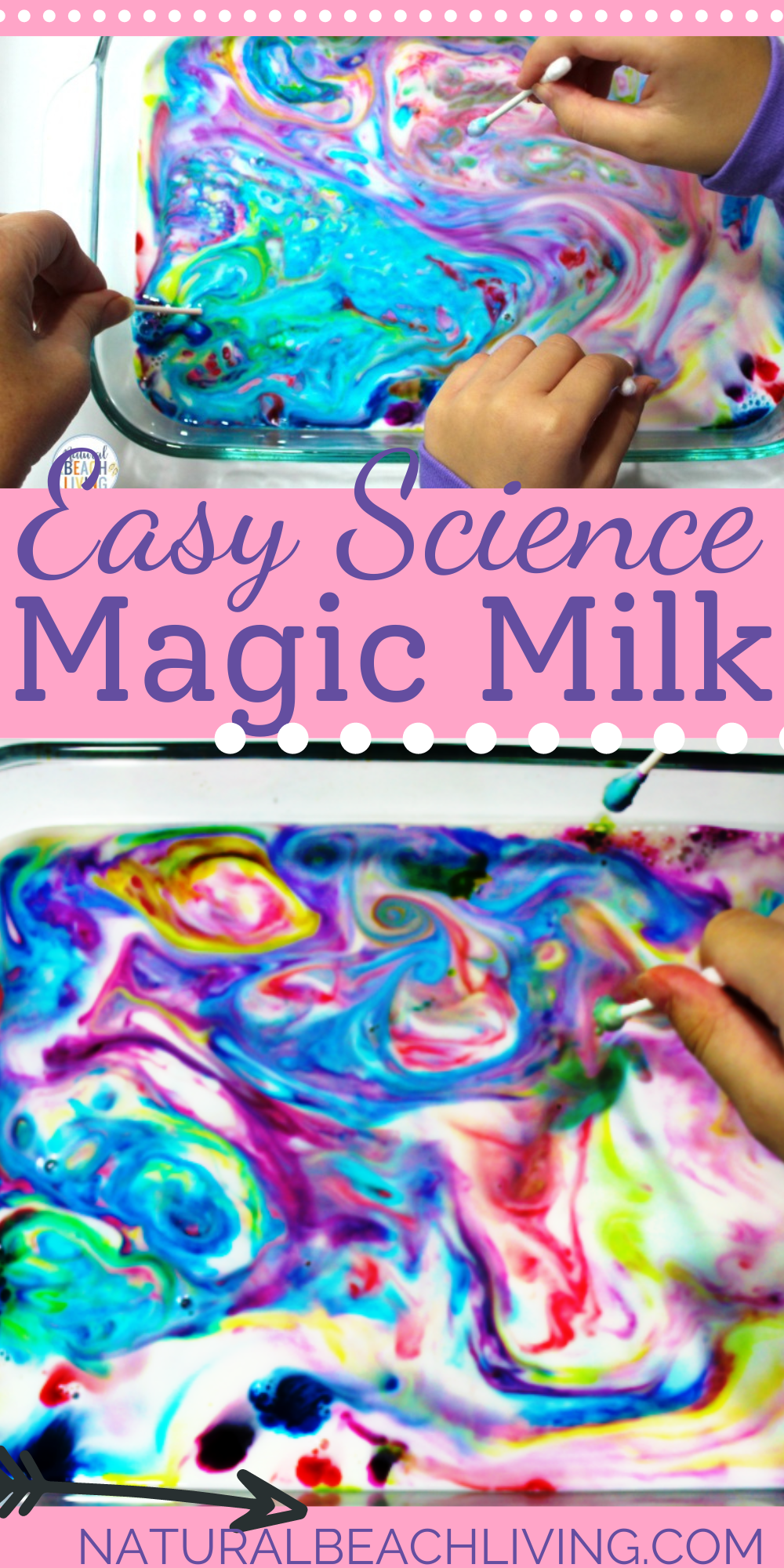
Materials needed for the Magic Milk Experiment
Gather all the essential materials for your experiment:
What you will need to make your Magic Milk Experiment is in the picture below. However, I have it displayed in list form towards the bottom of the page. Have Fun!
Science Project Ideas
If you are looking to make this a Montessori Science activity place these materials out on a tray for your children to enjoy for the day. If you want to do this activity together in a classroom or at home, this is all you need to make this a fun, hands-on science experiment.
affiliate links can be found on this blog at no cost to you.
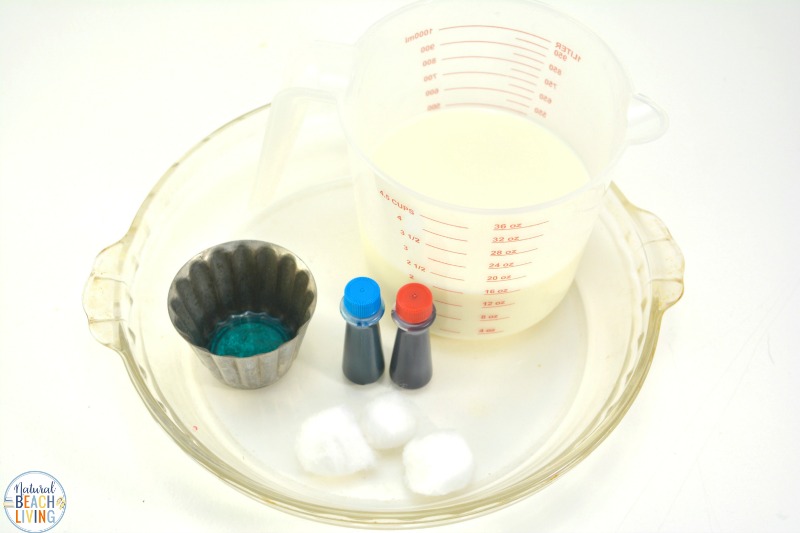
Color Changing Milk Experiment
For this experiment, you only need a gentle drop or two of liquid dish detergent directly in between color droplets.
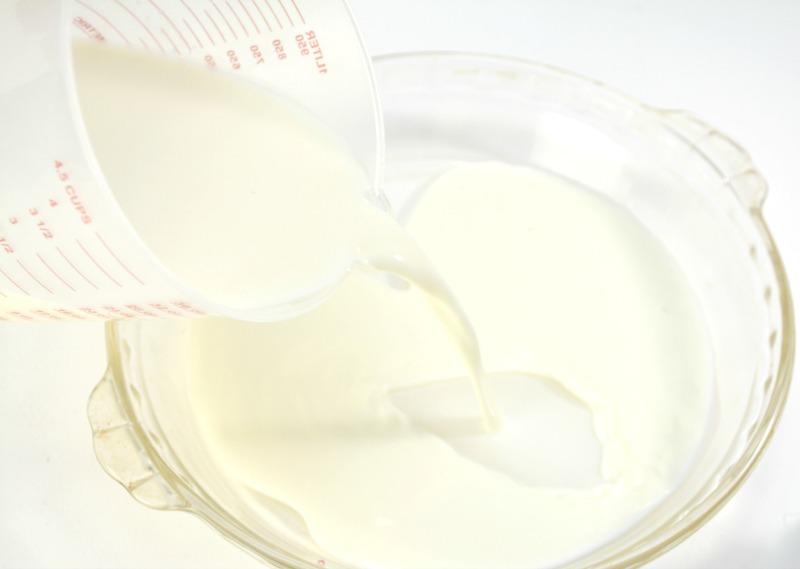
Begin by pouring some milk into a pie pan or shallow container.
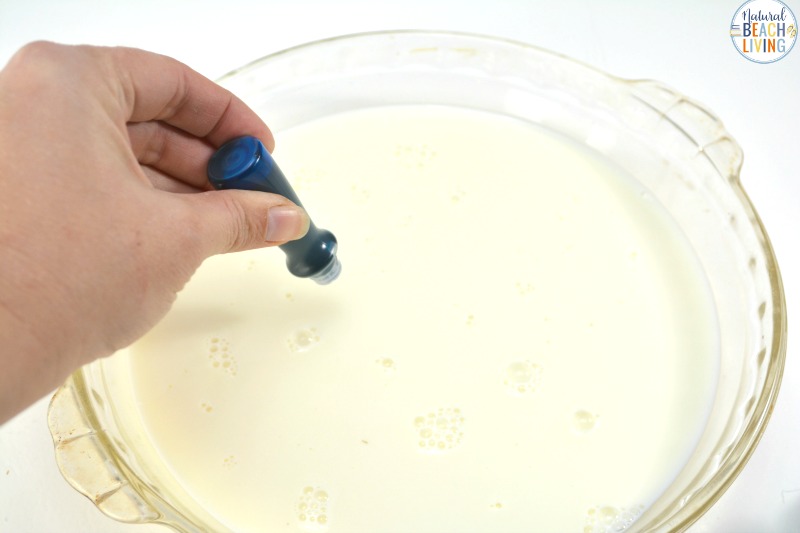
Add several drops of different colored food coloring scattered over the surface of the milk.
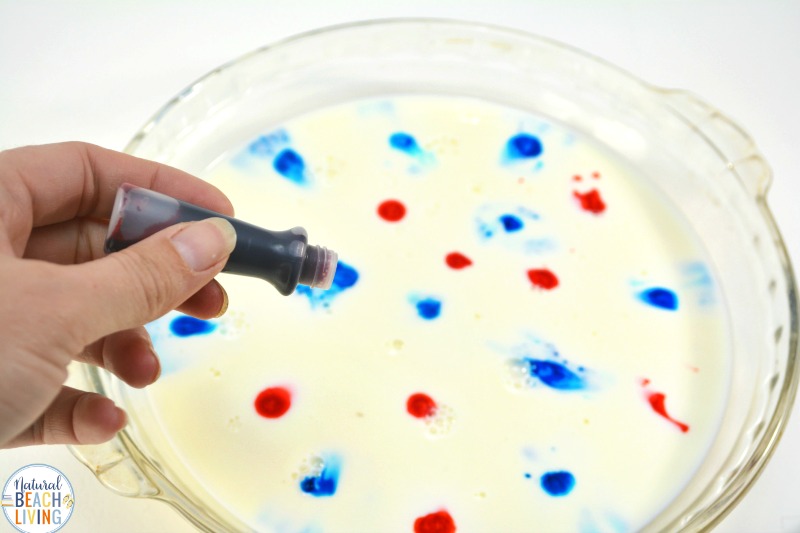
The reason behind the milk change is the molecules of fats and proteins in the milk are being broken down by the soap. Then the soap chases the fat molecules, trying to join with them.
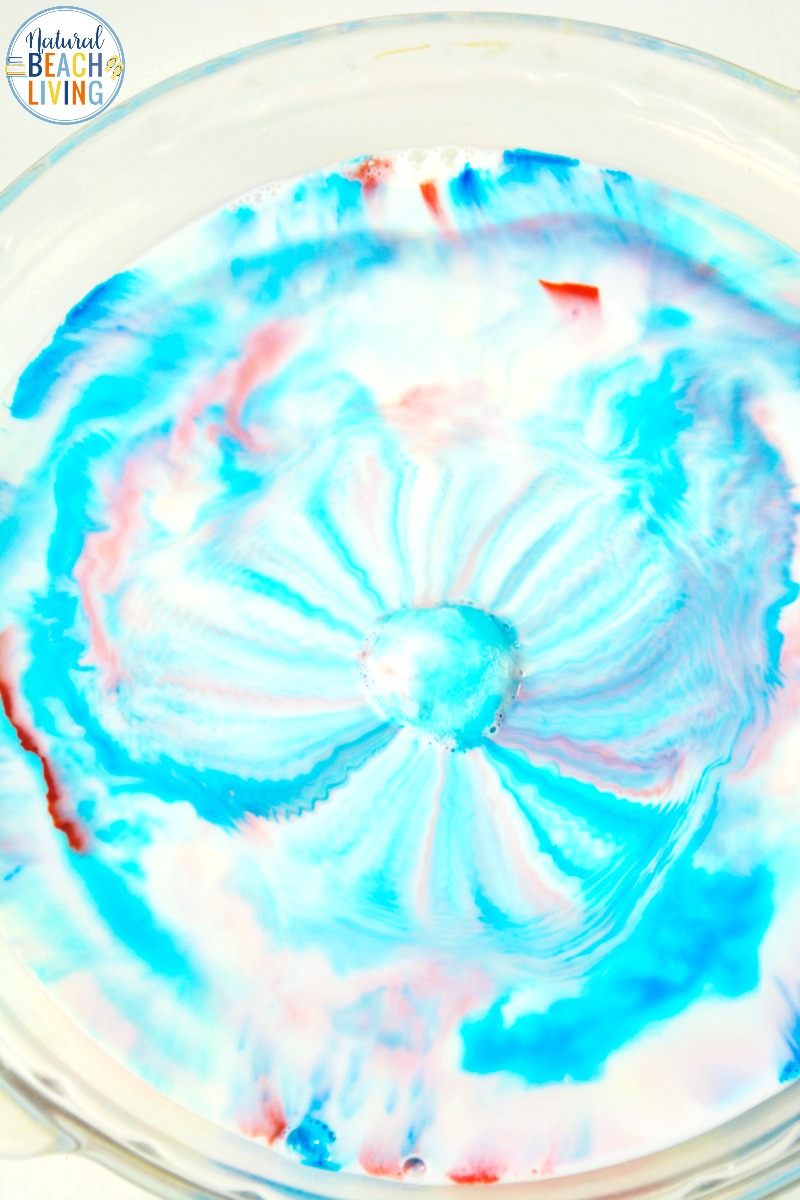
You can use cotton swabs to break apart colored molecules and watch how each reacts to the addition of soap. Now that you are prepped with supplies, you are ready to take part in an exciting experiment!
Magic Milk Science Activities for Kids
Montessori science activities.
This is an easy and super fun science experiment that uses common kitchen materials, so you probably don’t even need to go to the store. It only takes a couple of minutes to prepare on a tray, and children as young as 3 can do this science experiment independently.
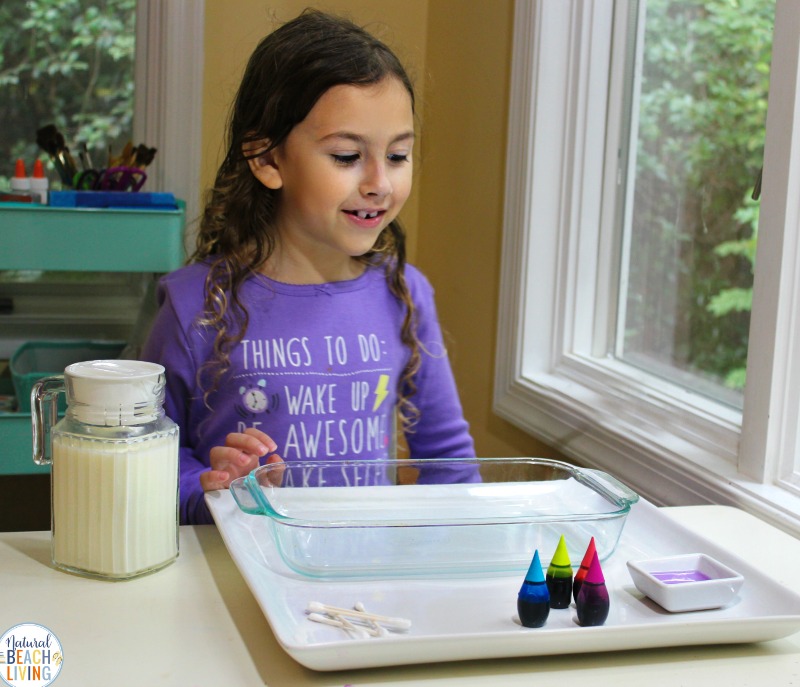
Magic Milk Science Experiment Lesson Plan
Not Only Science…
Encouraging your child to make art with everyday materials is a great way to fuel creativity. Allowing them to explore the process of pouring milk into a bowl and adding drops of food coloring can be an exciting activity for young minds.
Food coloring is non-toxic, and it’s a fun and easy way for your child to learn about how liquids can blend and blend to create unique color combinations. This activity not only promotes creativity but can also help develop hand-eye coordination and fine motor skills as well.
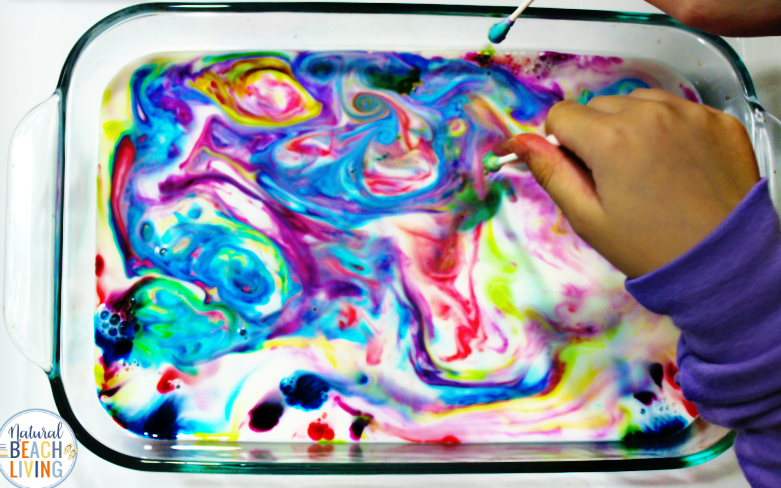
When the milk stops moving and the reaction is finished, you can repeat the steps as many times as your children like. You can also change up the colors depending on holidays and themes too.
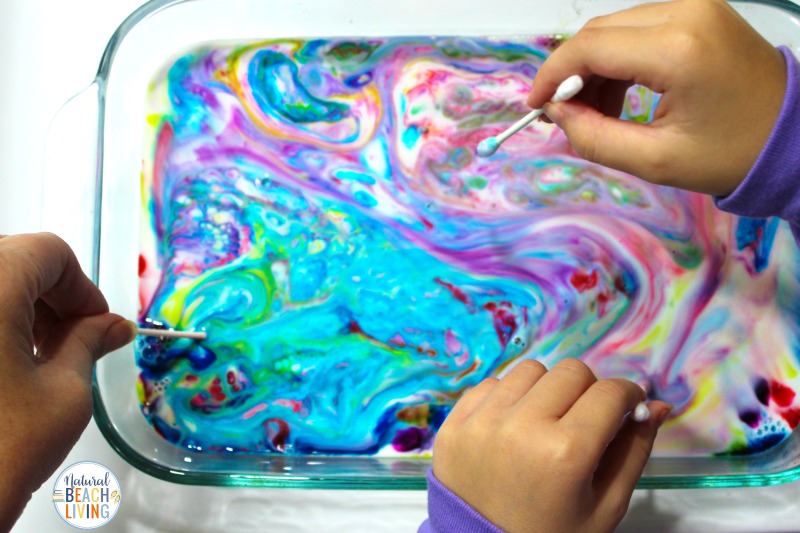
The swirls and bubbling of the milk colors kept going and going after the reaction. It was so cool to watch; the kids loved it!
Magic Milk Experiment
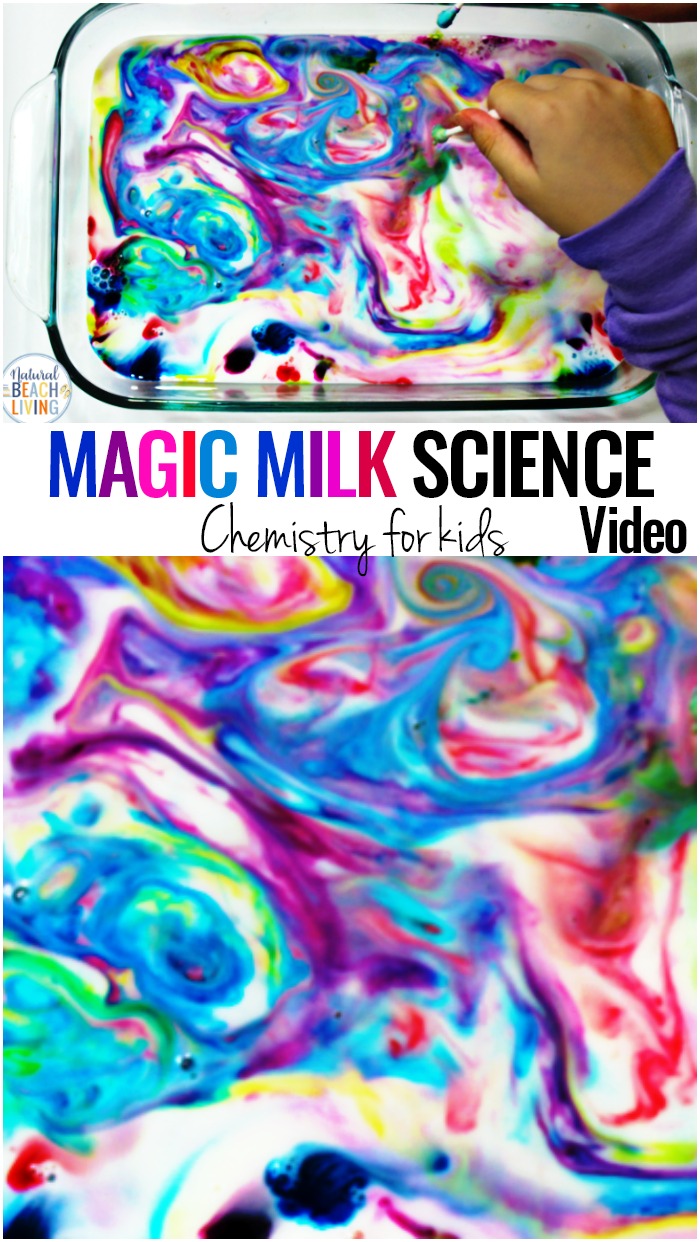
Have you ever wondered what happens when you mix milk, food coloring, and dish soap? With this magic milk science experiment, watch as the colors swirl around in a mesmerizing fashion. Each of the ingredients has its own properties that come into play during this experiment.
The lipid molecules in the milk are attracted to the dish soap, causing them to break apart. This creates a reaction that disperses all of the colors throughout, ultimately mixing them in a super cool way.
Try out this magic milk science experiment for yourself and feel like a scientist!
Preschool Science Experiments
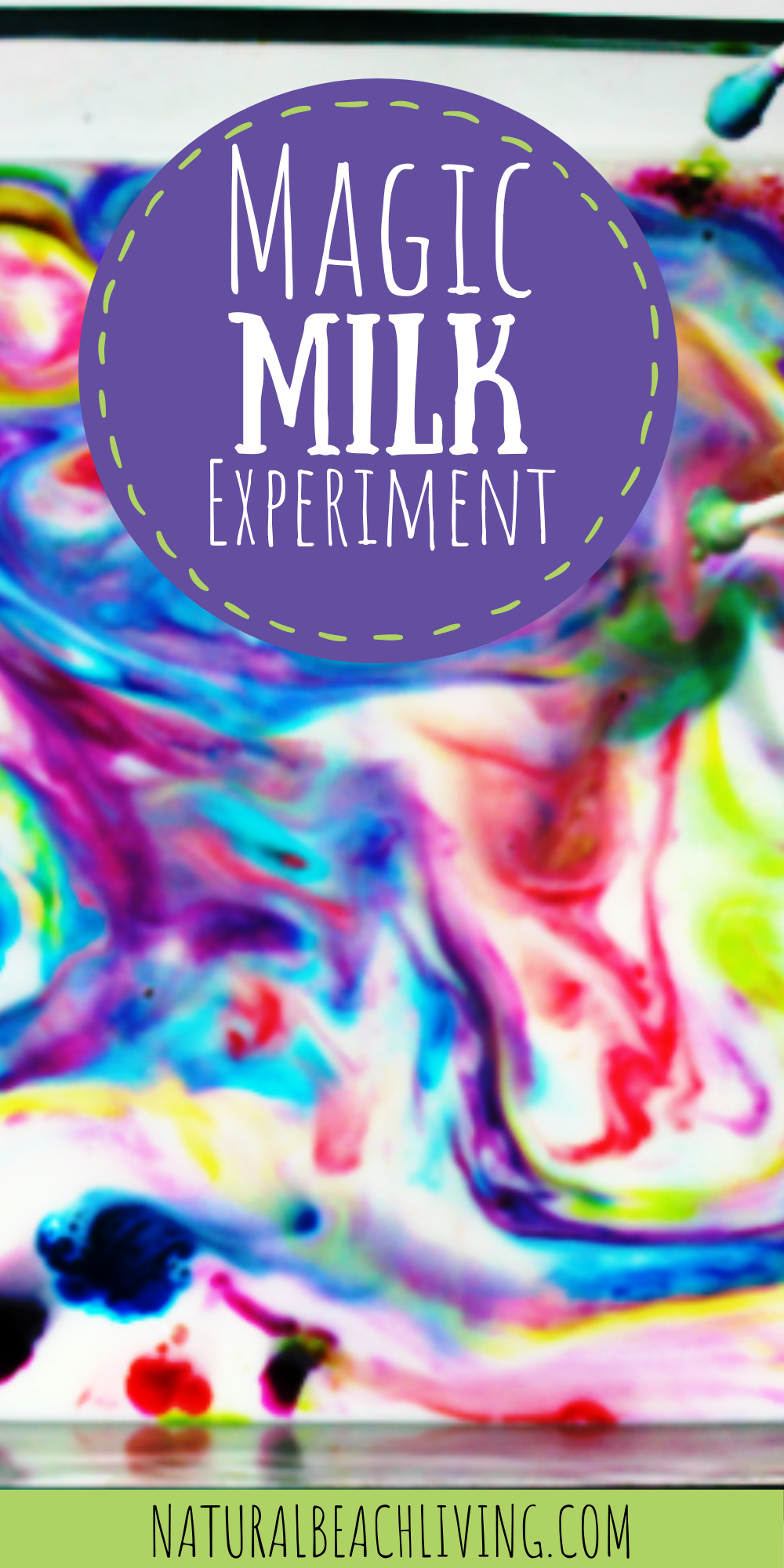
● Milk ● Pie pan or another shallow container ● Food coloring – We used Red and Blue ● Cotton balls or Qtips ● Blue colored dish soap
Instructions:
1. Begin by pouring some milk into a pie pan or other shallow container. 2. Add several drops of food coloring scattered over the surface of the milk. 3. Pour in some drops of red food coloring on the surface of the milk. For the best results, try not to mix the drops of food coloring together yet. 4. Dip a cotton ball into blue colored dish soap. 5. Place the soap covered cotton ball or Qtip into the center of the milk. 6. Watch as the colors magically swirl and twirl through the milk in the container. 7. You can dip additional cotton balls or Qtips into the dish soap and place them throughout the container into the milk to see the colors swirl in different directions.
**We used Blue and Red the first time because we enjoyed this Science Experiment over the summer (4th of July), then we did it again with a variety of colors. You can make this fun and add as many colors as you’d like. Think rainbow, or do other colors for different holidays.
Pin This Magic Milk Science Activity to Save for Later
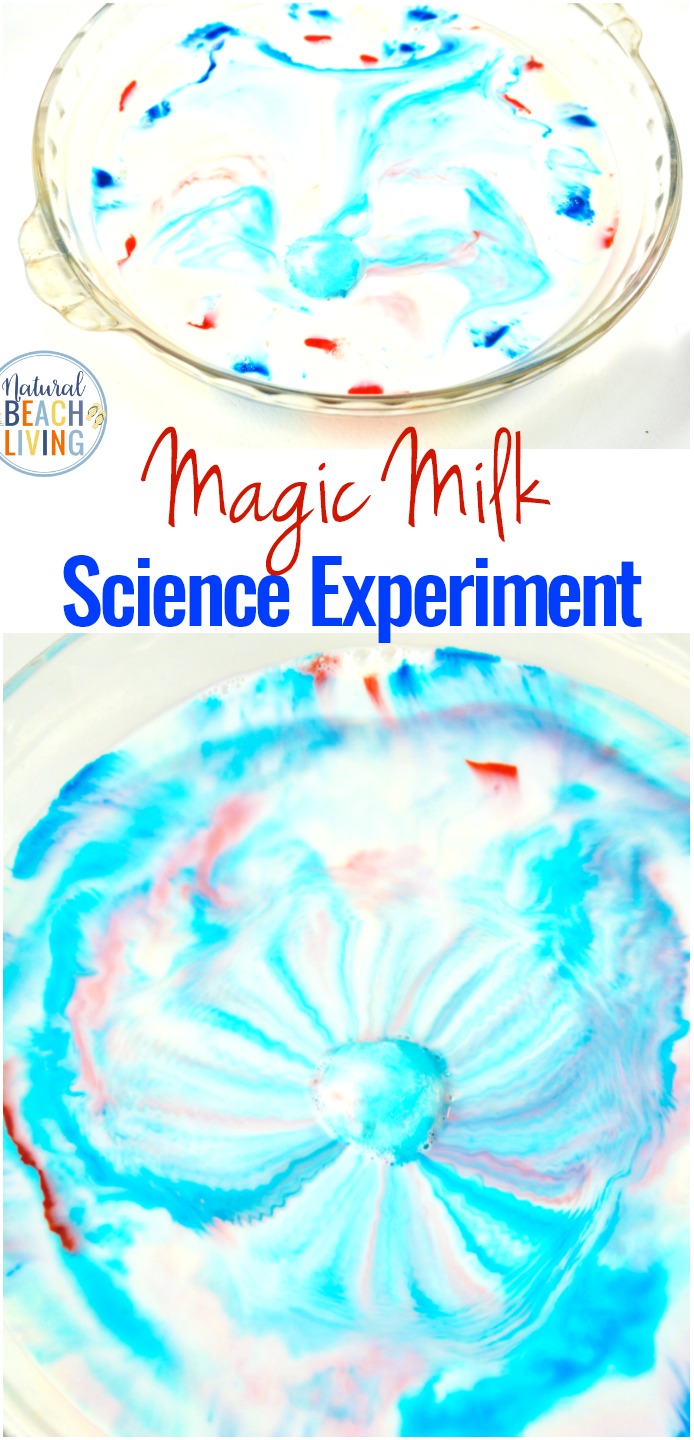
Engage your students and children by sparking their curiosity with the magic milk science experiment lesson plan!
This engaging activity gives them an opportunity to bring out their creative side, as it encourages them to explore the science behind making all sorts of magic colors. Whether they choose to examine the effects of changes in temperature or compare different brands of food coloring for the most vibrant results, each student will be delighted when it’s time to enjoy their colorful creation. As a bonus, you may also find that this experiment fosters a newfound appreciation for science among your students!
If you are interested in a more in-depth explanation, head over to Steve Spangler Science for a full explanation.
So there you have it – a simple but very magical activity that your child is sure to enjoy! If you’re looking for more preschool science experiments, be sure to check out some of our favorites below.
From exploring colors changing with Jelly Beans to creating homemade slime , there’s something for everyone.
Kids Activities
Studies have shown that if you like this, you will also love the following articles. I have pulled them together for you right here!
25+ Montessori Science Activities and Experiments for Kids
Tile art for kids – with video.
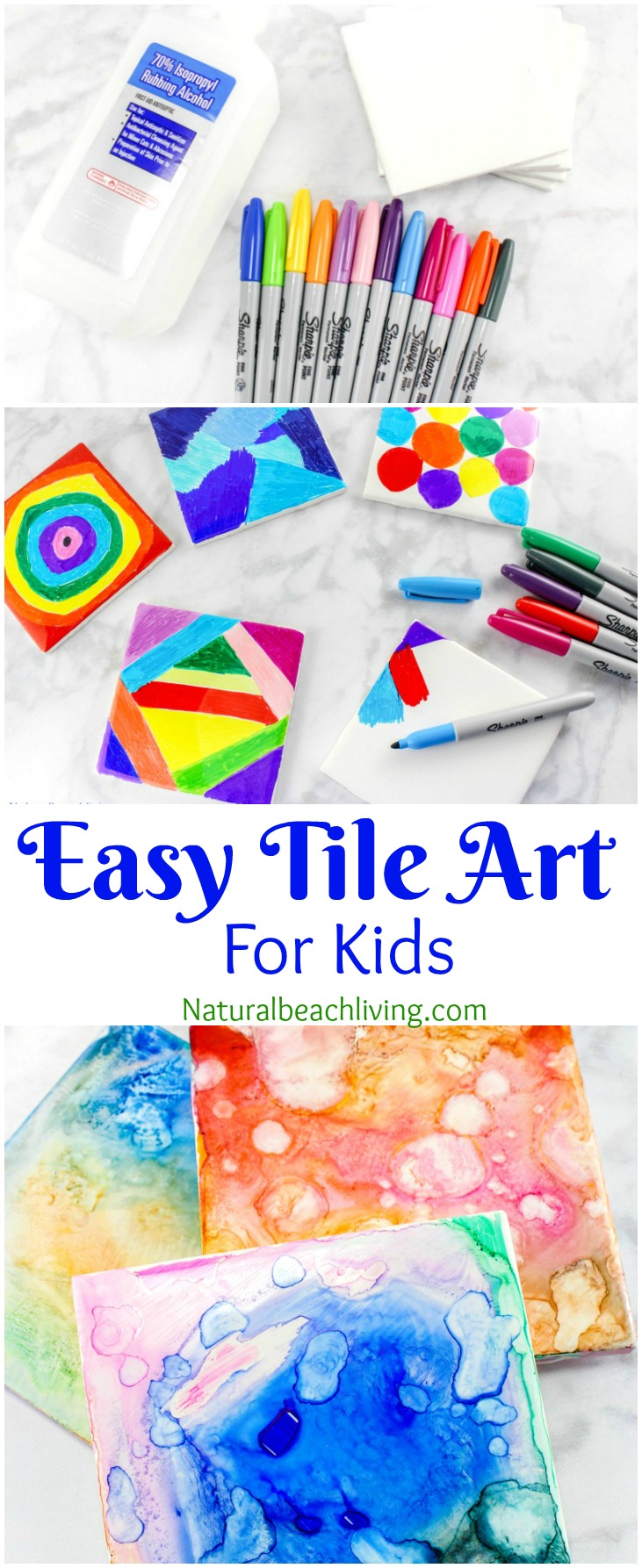
200+ Best Preschool Themes and Lesson Plans
Exploding colors milk rainbow.
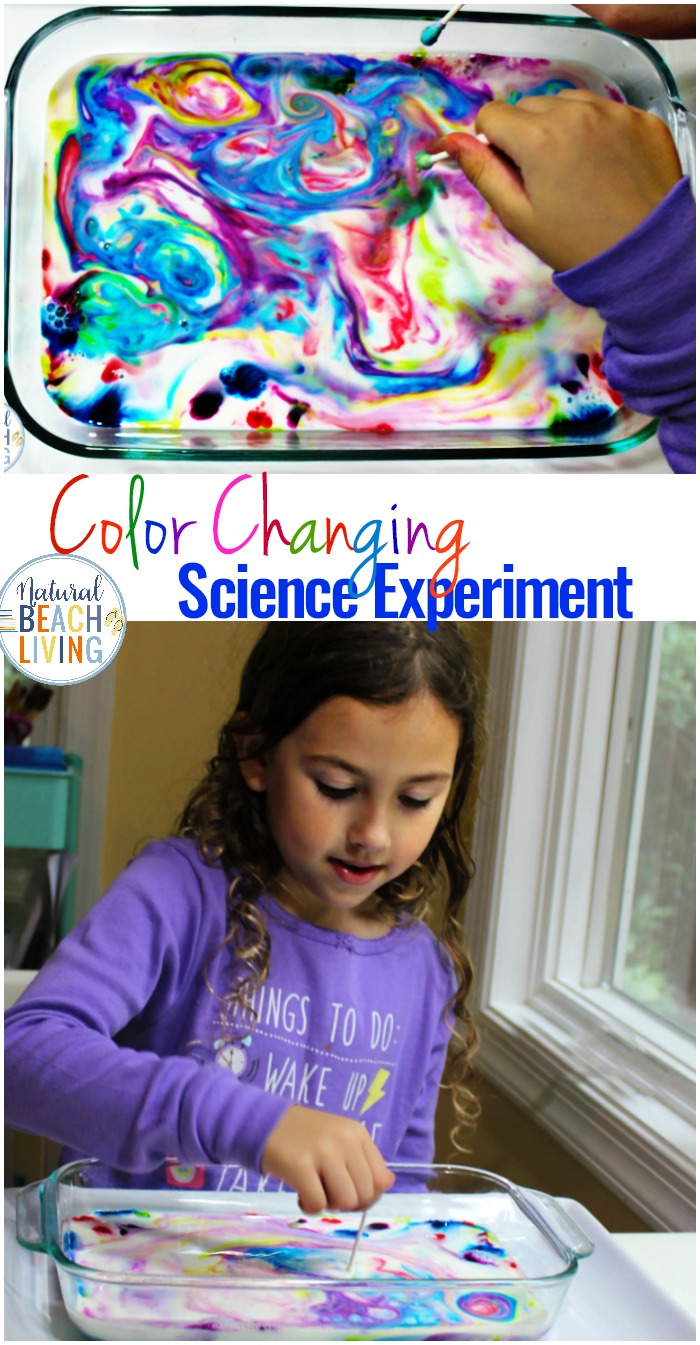

- Science Notes Posts
- Contact Science Notes
- Todd Helmenstine Biography
- Anne Helmenstine Biography
- Free Printable Periodic Tables (PDF and PNG)
- Periodic Table Wallpapers
- Interactive Periodic Table
- Periodic Table Posters
- Science Experiments for Kids
- How to Grow Crystals
- Chemistry Projects
- Fire and Flames Projects
- Holiday Science
- Chemistry Problems With Answers
- Physics Problems
- Unit Conversion Example Problems
- Chemistry Worksheets
- Biology Worksheets
- Periodic Table Worksheets
- Physical Science Worksheets
- Science Lab Worksheets
- My Amazon Books
Magic Milk Science Experiment for Kids

Nothing happens if you drip food coloring onto milk, but once you add a drop of dishwashing liquid, the milk turns into a swirling wheel of color. Here’s how to perform the magic milk science experiment and a look at how it works.
Magic Milk Materials
This is a great science project for kids because all you need is milk, food coloring, and dishwashing liquid. It’s also easy on your pocketbook because you only need a little of the ingredients.
- Food Coloring
- Dishwashing liquid
How to Do the Magic Milk Science Experiment
- Pour enough milk to cover the bottom of a small place or shallow saucer.
- Add a few drops of food coloring. You don’t need to use different colors, but if you do, you can explore how colors combine to make new ones.
- Observe how boring this is. The food coloring drops stay where you put them and may even sink into the milk and disappear.
- Drip a droplet of dishwashing liquid onto the center of the milk. You don’t need to stir the milk. The colors immediately start to swirl on their own.
How the Magic Milk Experiment Works
Adding food coloring to milk doesn’t have much of an effect. Yes, you can color the milk if you stir it, but if you don’t stir it the color spreads by diffusion . Diffusion is a slow process and not very interesting to watch.
When you add dishwashing liquid, the colors start to swirl. Dishwashing liquid is a detergent. Detergents lower the surface tension of the water in the milk, making it easier for the ingredients on the plate to mix. You can observe surface tension if you pour water or milk into a glass and note you can overfill the container slightly. The anti-gravity water science trick also relies on surface tension.
But, that’s not all detergent does. Detergent is an emulsifier . Each detergent molecule has a hydrophobic (“water-fearing”) and hydrophilic (“water-loving”) portion. The hydrophilic portion orients toward water molecules, while the hydrophobic portion orients toward fat molecules. The end result is that detergent forms tiny spheres called micelles that separate the fat from the water. Basically, an emulsifier helps two immiscible (unmixable) liquids mix. The food coloring swirls throughout the milk as the detergent forms micelles around fat globules within it. The fat content of the milk matters. Skim milk contains very little fat, so the detergent doesn’t have a big effect on it. 2% milk and whole milk work much better for the magic milk project because they contain enough fat to cause a visible reaction between the detergent and milk.
From Project to Science Experiment
Science projects work due to scientific principles. For young explorers, you can explain that detergent changes the properties of milk so colors added to it mix better. Explain that the same process happens when you wash dishes. The detergent makes it easier for oil and grease to lift from dishes and get rinsed away. Also, this is a great project for kids to explore colors. They can see that blue and yellow combine to make green, red and blue combine to make purple, and so on.
But, older children can turn the science project into a science experiment. The difference is that an experiment uses the scientific method . In a nutshell, an investigator observes the project, makes a prediction or forms a hypothesis about what will happen if one thing is changed, and then conducts and experiment to see if the prediction was correct. Here are some ideas of factors to change to turn the magic milk project into a true magic milk science experiment.
- What happens if you increase the fat content of milk? You can compare skim, 2% milk, whole milk, and half-and-half. Or, you can mix oil in with milk before continuing the project. Is there a point where the thickness of the milk slows down the reaction?
- Does the project work with water? With vegetable oil? What happens if you mix water and oil and try the project?
- What happens if you sprinkle glitter onto the milk before adding the detergent?
- Temperature affects the rate of many processes and chemical reactions. Is there any difference if you use very color milk compared with hot milk?
Related Posts

IMAGES
VIDEO
COMMENTS
With only four common kitchen items, kids are thrilled by the color explosion created by the hydrophilic and hydrophobic molecules in our magic ingredient! Watch our demonstration video, then print out a materials list and instructions to plan for this simple and fun science experiment.
Magic milk is a cool science experiment for kids of all ages! Learn how different molecules in milk interact with soap!
You have to try this cool Magic Milk Experiment! Teach your kids about colors, chemical reactions, and blow their minds at the same time.
Sign up for Cool Science Experiments FREE Weekly Newsletter: http://coolscienceexperimentshq.com/subscribeTo find even more cool science experiments visit: h...
In the magic milk experiment, kids learn about simple chemical reactions and physical properties using only a few ingredients. Read on to see how to do the experiment, and fill out the form on this page to grab your free recording sheet.
Introducing the Magic Milk STEM activity, an engaging and fun experiment for kids and preschoolers. This eye-catching activity provides a great opportunity for little scientists to observe fascinating color changes and reactions. Follow this friendly, step-by-step procedure to create some science fun at home.
Magic milk is a super cool chemistry experiment for kids! One of the best science activities for kids and makes a great STEAM activity too. https://littlebin...
This rainbow dancing Magic Milk Science Experiment is a super cool way to explore the chemistry of surface tension. Simple science for school or home.
The Magic Milk Science Experiment is a fun and simple experiment for children of all ages. It’s an excellent Science idea for preschoolers and Kindergarten as an introduction to learning about chemical reactions and colors.
The magic milk science experiment is a fun way for kids to explore color and learn about what detergents do. Nothing happens if you drip food coloring onto milk, but once you add a drop of dishwashing liquid, the milk turns into a swirling wheel of color.